new posts in all blogs
Viewing Blog: Frogs Are Green, Most Recent at Top
Results 26 - 50 of 295
Helping to bring awareness about the worldwide decline of frogs and other amphibians
Statistics for Frogs Are Green
Number of Readers that added this blog to their MyJacketFlap: 1
By: frogs are green,
on 5/1/2015
Blog:
Frogs Are Green
(
Login to Add to MyJacketFlap)
JacketFlap tags:
sustainable products,
Sustainable Choices,
Green and Natural Ideas,
and Neem Oils,
Bryn Huntpalmer,
eliminating germs,
environmentally-friendy products,
Grapefruit Seed Extract,
Modernize.com,
natural cleaning materials,
non-toxic cleaning materials,
pet-friendly cleaning products,
Tea Tree,
vinegar lemon and baking soda,
Orange,
going green,
How You Can Help,
Environmental Health,
Chemicals in the Environment,
Add a tag
Guest blog by Bryn Huntpalmer
Going green and eliminating germs is easier said than done, and you’re not alone if you feel like the majority of kitchen cleaners on store shelves contain harsh chemicals that are anything but environmentally-friendly. A few years ago, I decided to ditch the bleach and keep my kitchen clean with all-natural cleaners, and I couldn’t be happier. Here’s how to do it:
Clean with Natural or Non-toxic Cleaning Materials
Dishes, countertops, appliances, and any place that has seen a piece of raw meat needs cleaning and disinfecting. You can use natural materials to create cleaning products for any situation.
The basic ingredients for almost any type of non-toxic disinfectant are:
- Vinegar
- Lemon
- Baking Soda
- Hydrogen Peroxide
- Tea Tree, Orange, and Neem Oils
- Grapefruit Seed Extract
Clean the refrigerator and countertops with baking soda. About a quart of warm water and a couple tablespoons of baking soda will give you a solution you can use to effectively clean quite a few things. Baking soda is actually a versatile substance. You can also use it to make a paste that can lift stains off cups and pans. Even better, when you’re done with the baking soda, you can pour it down the kitchen drain. It can help to get rid of and keep away bad drain odors.
Let your disposal unit grind down a lemon. Really, you can use any kind of citrus rind or peel to freshen the unit. You can also throw in some vinegar or baking soda (or both). Tossing in a few ice cubes can also help knock some debris off the disposal’s blade.
Add vinegar to the dish soap. You don’t need that fancy, overpriced dish soap. Get the cheapest brand you can find and simply add in a little vinegar (the ratio should be 10:1, with that smallest amount being vinegar). Vinegar cuts grease. And that’s just one of the things it does. Vinegar is really a miracle cleaner for your kitchen. For instance, you can clean your kitchen windows with vinegar. Just mix equal parts vinegar and water in a spray bottle.
Clean and freshen food prep areas. In a spray bottle, combine half a cup of white vinegar, 3 cups of water, and 10 drops of tea tree oil. Use this mixture to clean cutting boards, sinks, countertops, and other hard surfaces.
With these basic ingredients, there are almost an unlimited number of cleaning and disinfecting solutions you can make. You can use them in every part of your kitchen and all over the house. Just search for cleaning recipes involving any one of the listed things.
Even the solutions listed here aren’t the only way to accomplish any particular task. By cutting out the use of hazardous, chemical-based cleaners, you will make your kitchen clean, safe, and definitely green.
For more home tips and tricks, head to Modernize.com.
By: frogs are green,
on 4/27/2015
Blog:
Frogs Are Green
(
Login to Add to MyJacketFlap)
JacketFlap tags:
Climate change and the Environment,
Frogs in the Classroom,
wildlife conservation,
Eco Interviews,
Amphibian Education Programs,
State Amphibian,
Amphibian advocate,
Bitterroot Mountains,
Dr. John Cossel,
House Committee,
Idaho Giant Salamander,
Idaho State Amphibian,
Ilah Rose Hickman,
Northwest Nazarene,
Operation Freedom,
Salamander Camp,
Jr.,
biodiversity,
Salamanders,
Learn about Frogs,
How You Can Help,
Children and Nature,
People Helping Frogs and Toads,
Frog People,
Add a tag
Below is a written interview with Ilah Rose Hickman, who fought for the Idaho State Amphibian, the Idaho Giant Salamander. I was also fortunate to interview Ilah on my Suzy Brandtastic podcast series. Since writing this interview the bill passed and Idaho now has a State Amphibian!
Listen here: Ilah Rose Hickman eco-interview podcast
Please tell us a bit about your mission and goals…
 I started my legislative journey in 4th grade when we learned about Idaho history in social studies. In the unit on Idaho state symbols, our teacher gave us an assignment to create a new symbol and then write a mock letter to our legislator and ask them to support the proposed symbol. When I went home that day I told my Mom I wanted to propose a new symbol for real, and not just for a mock assignment. So that’s how it all began!
I started my legislative journey in 4th grade when we learned about Idaho history in social studies. In the unit on Idaho state symbols, our teacher gave us an assignment to create a new symbol and then write a mock letter to our legislator and ask them to support the proposed symbol. When I went home that day I told my Mom I wanted to propose a new symbol for real, and not just for a mock assignment. So that’s how it all began!
What is your educational background and what lead to this mission?
I am now in 8th grade at Les Bois Junior High in Boise Idaho. Ever since that fourth grade assignment, I have been determined to have a new state symbol designated in Idaho. In fourth grade I learned that many other states had a state amphibian or reptile designated, but Idaho did not. So I decided to research amphibians and reptiles, and also found out who my representatives were in the legislature and wrote to them. My district Senator met with me in the summer before 5th grade and recommended I pick one symbol, so after my research I decided to choose the Idaho Giant Salamander as a state amphibian. In 6th grade I had a committee hearing in the House but the bill did not go any further than that. In 7th grade the bill started in the Senate, and it passed all the way through the full Senate but then the House committee ran out of time and I did not get a hearing there.
Now this year the bill was given a committee hearing in January, and they voted against sending it to the full House for a vote. But then last week the committee Chairman called us and said they had “revived” the Bill and yesterday it went to full House for a vote and passed 51-17. Now I am hoping it gets to the Senate before the legislature adjourns this session.
Of the 15 amphibians native to Idaho, I chose the Idaho Giant Salamander because it has “Idaho” in its name, it resides almost exclusively in Idaho (and just a sliver of adjacent Montana) and the marbled brown pattern on the adult’s skin looks like a topographical map of the Idaho Bitterroot mountains. Other native amphibians like frogs and toads are already designated as amphibians in other states, and many of them live in widespread areas beyond Idaho.
What are some challenges you have faced and how did you deal with them?
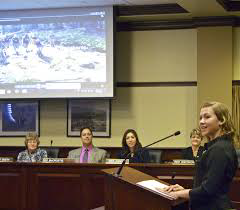 I have had to learn patience! I have had to wait a whole year multiple times because once the bill “dies” or is “killed” by a committee, you are done for that year and have to wait for the next session. Also, many legislators have said no to my bill. But every time they have said no it has pushed me forward by encouraging me to come back the following year and be better prepared to persuade them better to get an “aye” vote. Last summer I went to a “salamander” camp with a local biology professor and his students to capture, tag, collect data, and release Idaho Giant Salamanders in a stream near the Lochsa River. This really helped me in my testimony to the committee this year. And after the House committee voted against sending it to the full House for a vote this session, I sent letters to a lot of 4th grade teachers in the districts of those legislators who voted no, and told the about the bill, their legislator’s “no” vote, and reasons they could support the bill and asked them to write their legislators. I think that kind of statewide support from other students and educators helped a bill like mine.
I have had to learn patience! I have had to wait a whole year multiple times because once the bill “dies” or is “killed” by a committee, you are done for that year and have to wait for the next session. Also, many legislators have said no to my bill. But every time they have said no it has pushed me forward by encouraging me to come back the following year and be better prepared to persuade them better to get an “aye” vote. Last summer I went to a “salamander” camp with a local biology professor and his students to capture, tag, collect data, and release Idaho Giant Salamanders in a stream near the Lochsa River. This really helped me in my testimony to the committee this year. And after the House committee voted against sending it to the full House for a vote this session, I sent letters to a lot of 4th grade teachers in the districts of those legislators who voted no, and told the about the bill, their legislator’s “no” vote, and reasons they could support the bill and asked them to write their legislators. I think that kind of statewide support from other students and educators helped a bill like mine.
What can people do to help? Donate and contribute to your cause? Other ideas?
Throughout this 5 year process, I have had many students, teachers, and other residents write letters to the representatives of their districts in support of this bill. Even young students in first or second grade have drawn pictures of salamanders and sent them to their legislators. If someone lives in Idaho they can write their legislator and ask them to support the Bill. I also have a Facebook page set up to keep people (in and out of Idaho) up to date on what’s happening with the Bill.
How do you reach your targeted audience? Is it through your website, advertising or social media or another route? Which is most effective and why?
I use my Facebook page to communicate with supporters, and over the years I have emailed lots of teachers and asked them to support the bill by having their students write to their legislators. At my own school I have had a ballot box in the library, and my Earth Science class wrote letters of support. I visited a 4th grade class here in Boise and told them about my experience, and I’ve been interviewed on a few radio stations here in Idaho to talk about my bill.
How do you keep the audience engaged over time?
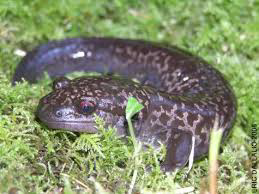 Each year I have learned more about the legislative process, the politics involved, and I keep learning more and more about the salamander as well. Scientists and other amphibian fans contact me with research, stories and other data that has helped me strengthen my arguments for this bill, and I try to communicate all of this to the supporters of the bill by Facebook, and in my testimony, and other interviews.
Each year I have learned more about the legislative process, the politics involved, and I keep learning more and more about the salamander as well. Scientists and other amphibian fans contact me with research, stories and other data that has helped me strengthen my arguments for this bill, and I try to communicate all of this to the supporters of the bill by Facebook, and in my testimony, and other interviews.
Tell us about your events around the world and some of the campaigns you have started.
What is in the works for the future? What haven’t you yet tackled, but will want to do soon?
This week I am working hard to get the Bill to the Senate floor before they adjourn for the year. I am 50 percent done and am hoping to get it passed this year!!! If the Bill does not get through the Senate, I will be back next year. I also hope to get to go back to “salamander camp” in the summer with the biology professor because that was so educational and a lot of fun!
Would you like to add anything not discussed above?
I have been passionate about this project because once I begin something, I like to see it through to the end. And so I want to keep going with this until the Bill passes. I also really love all animals
and learning about them. And once I learned about the Idaho Giant Salamander, I just thought it was such a cool animal because “amphibian” means double life, and this one is so special and unique to Idaho. Salamanders in general are valuable in areas like medical research (because they regenerate lost limbs),
climate control (because they contribute to the forest carbon cycle), and are different than any other animal state symbol we already have.
Learn more:
On Facebook: Idaho Giant Salamander for State Amphibian
YouTube link to a video about the Idaho Giant Salamander:
(This is what I showed to the House committee. One of the professors at salamander camp made it for me.)
-Ilah Rose Hickman
By: frogs are green,
on 4/21/2015
Blog:
Frogs Are Green
(
Login to Add to MyJacketFlap)
JacketFlap tags:
Wes Deyton,
Pershing Field Garden Friends,
save the bees,
Children's Books on Frogs,
Frogs and Artists,
Amphibian Education Programs,
amphibian art curriculum,
Irwin Quagmire Wart,
#JCMakeItYours,
2nd annual green dream,
70s frog poster,
bee poster,
Earth Day at JC City Hall,
Earth Day in Liberty State Park,
frogs amphibians and Their Threatened Environment,
Green Is Good,
mary ann farley,
save the honeybee,
Earth Day,
Environmental Books,
frog book,
biodiversity,
Learn about Frogs,
How You Can Help,
Children and Nature,
frog exhibits,
Frog Conservation,
People Helping Frogs and Toads,
Frog People,
Read about Frogs,
Literary Amphibians,
Climate change and frogs,
frog poster,
frog gifts,
Save the Frogs Day,
frogs as bioindicators,
Frog fun,
Kids Art Contest,
Frogs Are Green kids' art contest,
Climate change and the Environment,
Frogs in the Classroom,
Ideas for a Green Holiday,
Green Dream,
Add a tag
Each year as Earth Day approaches, Frogs Are Green goes into high gear.
Sunday, April 19, we celebrated with our local (and not so local) area, as many came out on a beautiful spring day to the Pershing Field Vietnam Veterans Memorial Community Center in Jersey City Heights, to see the winning artworks done by children around the world.
Visit this link to see the whole gallery of the event on Facebook: 2nd Annual Green Dream

Pictured above is Laura Skolar, President of Pershing Field Garden Friends; Jersey City, City Council President Rolando Lavarro, Jr. and Me.
We’ve published our “Frogs, Amphibians and Their Threatened Environment” six-week curriculum book on Amazon and Createspace!
Pick it up here >> Frog and Art Curriculum
We have two new awesome posters: one for “Saving the Bees” with a gorgeous micro close-up by wildlife photographer, Wes Deyton… and our adorable “Naturally FROGADELIC” illustrated by the always original, Mary Ann Farley.
Visit our shop here: Frogs Are Green Shop
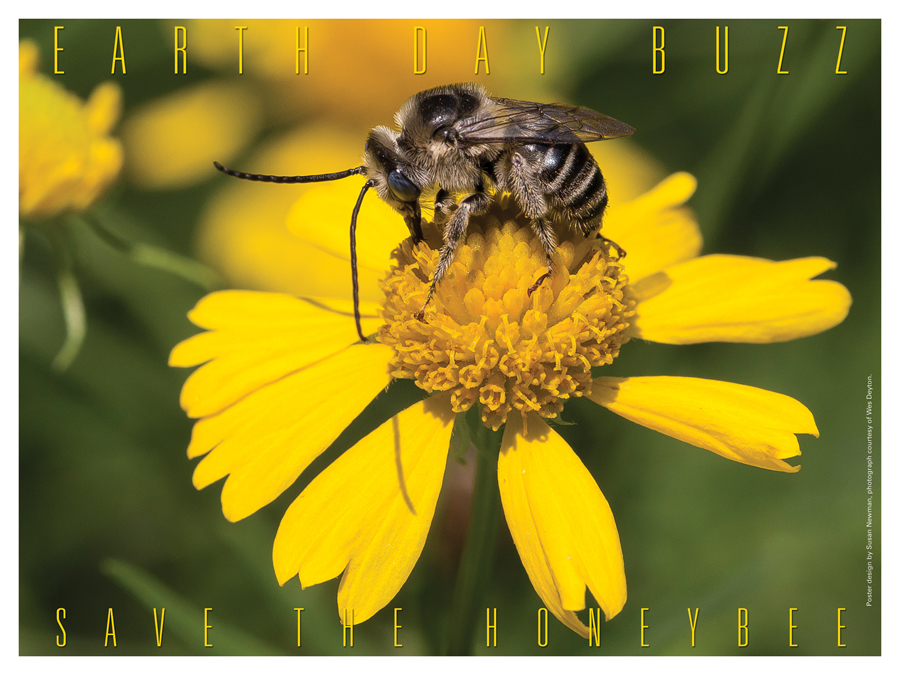
Earth Day Buzz – Save the Honeybee – Photograph courtesy of Wes Deyton.
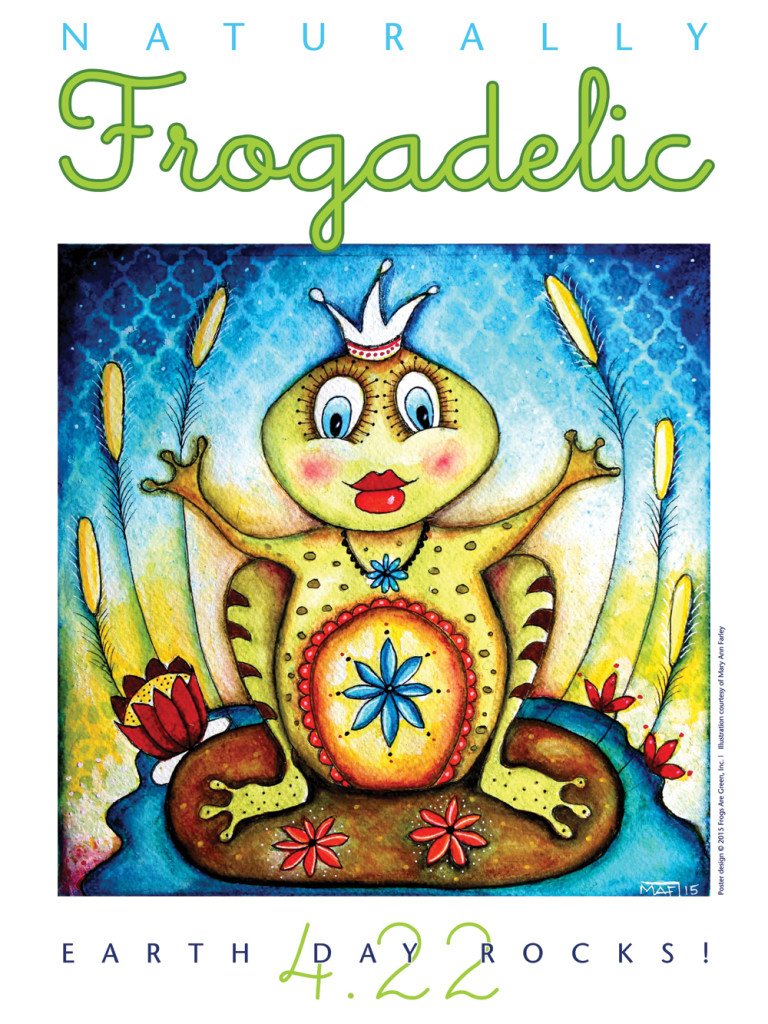
Naturally Frogadelic – Earth Day Poster 2015 by Susan Newman, founder, Frogs Are Green; Illustration courtesy of Mary Ann Farley.
We also want to share that our favorite Frog author, Irwin Quagmire Wart has written a new book and you can pick up a free download 4/21 – 4/25: >> Green Is Good
On Saturday, April 25th, Frogs Are Green will visit Liberty State Park’s Earth Day Festival and Sunday, April 26th, we will have a tent/table at the Earth Day festival in front of Jersey City’s City Hall! Children will be able to sit and draw pictures of frogs and nature. Art supplies and frog/amphibian reference on hand.
Swing by and visit us and have a fabulous EARTH DAY (week) and Happy Save The Frogs Day too!
– Susan Newman, founder
By: frogs are green,
on 4/15/2015
Blog:
Frogs Are Green
(
Login to Add to MyJacketFlap)
JacketFlap tags:
carbon neutral,
algae,
algae to biofuel,
alternative energy source,
biocrude,
bioenergy,
cleaner greener tomorrow,
Energy-BioenergizeME Infographic Challenge,
Erika Nemeth,
jet fuel,
Jillian Pesce,
Olivia Faulhaber,
Ruisi Zhong,
Smithtown HS,
St. James NY,
U.S. Department of Energy,
Uncategorized,
Add a tag
With the growing concern that humans will dry the earth of its limited fossil fuels, scientists are searching for an alternate energy source. One of the sources that has flown under the radar is algae. It can be used as jet fuel, biodiesel, and even biocrude. With minimal nutrient inputs, it can be grown in salt and waste water, thus leaving clean water for humans to drink. It is also carbon neutral, which means it absorbs as much carbon dioxide as it produces. Although harvesting algae on a commercial scale is currently inefficient, scientists are hopeful that algae will one day account for most of the world’s oil. Considering algae’s speedy growth and large presence throughout the world (making up 70% of the world’s biomass), its potential is enormous. Once its price is lessened from a current $8 a gallon to a more reasonable cost, you can expect to be filling up your car with algal biofuels instead of fossil fuels!
This project was fun for me because it taught me about something that is important on a larger scale. I hope to someday do research on this topic and improve on the technology used to turn algae into fuel. I want to spread awareness of algal biofuels to gain support for this amazing opportunity we have to change the world.
This infographic was created by students from Smithtown HS East in St. James, NY, as part of the U.S. Department of Energy-BioenergizeME Infographic Challenge. The BioenergizeME Infographic Challenge encourages young people to improve their foundational understanding of bioenergy, which is a broad and complex topic. The ideas expressed in these infographics reflect where students are in the learning process and do not necessarily reflect the state of knowledge of the U.S. Department of Energy or other experts in the bioenergy industry.
Learn about the amazing uses for algae as a biofuel! It’s the future of our world, and will create a cleaner and greener tomorrow! Just click on the link below to learn more.
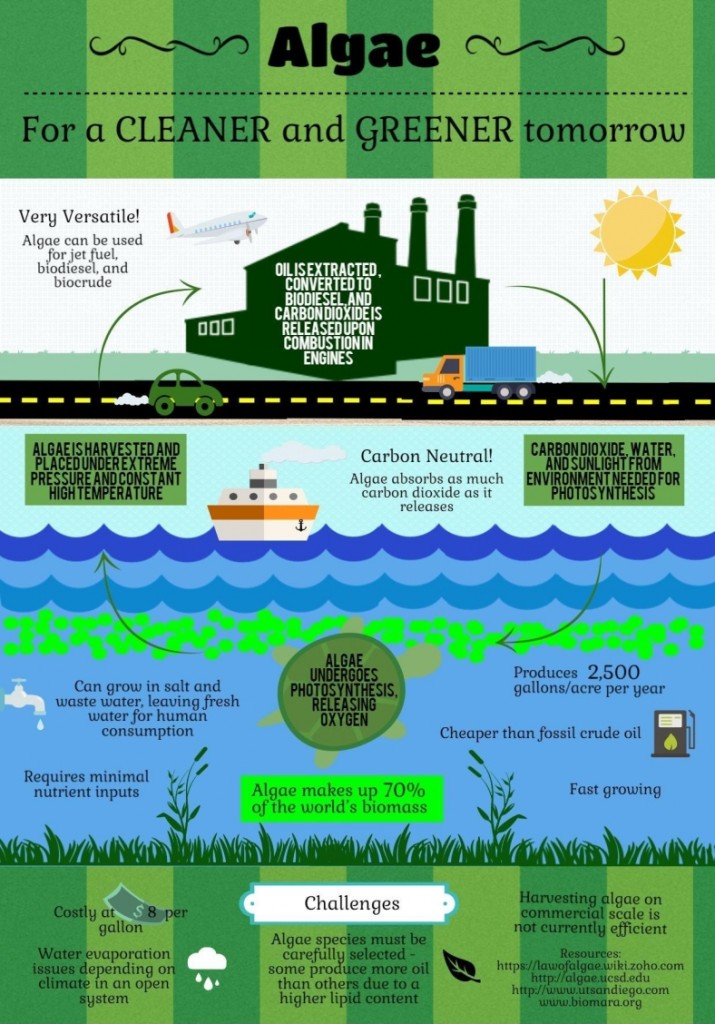
Guest blog by Jillian Pesce with Erika Nemeth, Olivia Faulhaber and Ruisi Zhong. We are a part of the BioenergizeME Competition for the U.S. Department of Energy.
By: frogs are green,
on 4/6/2015
Blog:
Frogs Are Green
(
Login to Add to MyJacketFlap)
JacketFlap tags:
Insects,
ecosystem,
biodiversity,
Learn about Frogs,
How You Can Help,
habitat loss,
Environmental Health,
Frog Conservation,
People Helping Frogs and Toads,
Chemicals in the Environment,
Frog People,
Climate change and frogs,
pest control,
frogs as bioindicators,
Creating a Wildlife Friendly Backyard,
Teaching Kids about Frogs,
Climate change and the Environment,
frogs are bioindicators,
A-Z Frogs,
wildlife conservation,
Frogs and Insects,
ban pesticides,
frogs eat insects,
frogs in the garden,
harmful pesticides,
healthy garden,
Add a tag
Frogs and toads, just like so many other animal species, are suffering a decline in numbers. This is due to environmental problems, climate change and human factors and show that the changes we are seeing in the environment are signs that something is wrong.
What many people should realize is that frogs need to be viewed as an important part of the ecosystem.
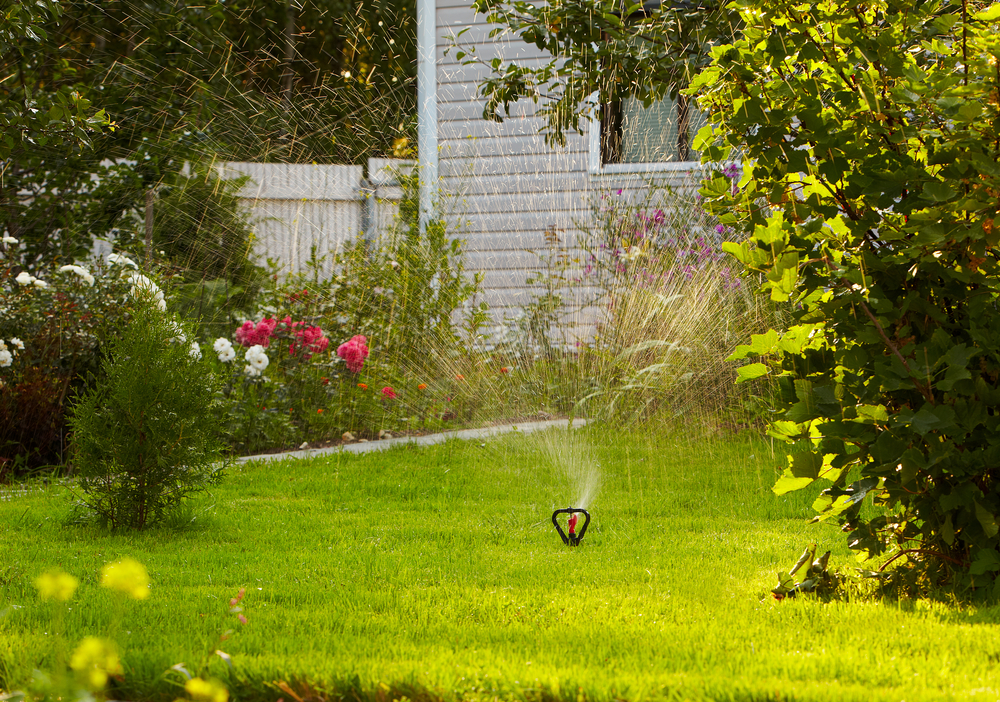
Frogs and toads are not only very beautiful and diverse (Frogs per Wikipedia – approximately 4,800 species); they can also prove to be very beneficial for your garden.
- Every ecosystem is comprised of multiple species that create a chain. It is what keeps the balance in nature and what maintains life as we know it. As such, frogs and toads have their place under the sun and should be protected. This is the reason why you will do very well to ensure that frogs can find shelter in your garden. If you provide the right conditions and features for these amphibian creatures, they should appear.
- Frogs are good bioindicators. There is a lot that you can learn from the frogs in your garden. Frogs can show you that something is wrong in the area, or if they are happily breeding and living in the area, then everything should be okay. If you are dedicated and want to have a perfect garden, you can use the indications from frogs to know if the conditions in your garden are good, or if the frogs that used to dwell there suddenly go missing, you will know there is a disturbance.
- Pest control – frogs are amazing at cleaning the garden from harmful insects. If you are having such problems, you can easily eliminate them by introducing frogs among your plants. A single frog can eat over 100 insects, such as caterpillars, sow bugs and cutworms and more. These can destroy your entire garden if left unchecked. With frogs around, you won’t need to use harmful pesticides, either.
Toads and frogs can be one of the best solutions for your garden. Not only will you have a garden safe of bugs and insects, but you will also have very pleasant amphibians hopping around.
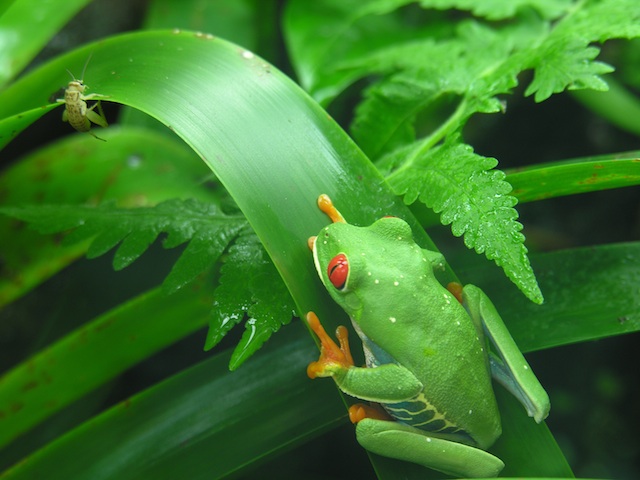
Tree Frog and Bug from EarthRangers.com
Guest post by Ella Andrews.
By: frogs are green,
on 4/5/2015
Blog:
Frogs Are Green
(
Login to Add to MyJacketFlap)
JacketFlap tags:
Leonard Lopate,
Environmental Books,
biodiversity,
WNYC,
Learn about Frogs,
How You Can Help,
Environmental Health,
Frog Conservation,
Frogs and the Rainforest,
People Helping Frogs and Toads,
Frog People,
Deforestation and frogs,
Literary Amphibians,
Climate change and frogs,
Deforestation and amphibians,
chytrid fungus,
Chytrid disease,
Frogs and Medicine,
Climate change and the Environment,
newly discovered frogs,
Photographing Frogs and Toads,
wildlife conservation,
Eco Interviews,
Amphibian Education Programs,
In Search of Lost Frogs,
Robin Moore,
Amphibian & Wildlife Bloggers,
water quality,
10 tips for nonprofit's awareness,
build a following,
building awareness,
chytid fungus,
frogs going extinct,
kids frog art project,
nonprofit awareness,
poisonous dart frogs,
Robin Moore interviewed by WNYC Leonard Lopate,
saving frogs and amphibians,
Add a tag
The phone is ringing and a friend is excited to tell me there’s a discussion about frogs right now on WNYC radio. Robin Moore, the author and photographer of “In Search of Lost Frogs,” is being interviewed on the Leonard Lopate Show (The Conservation Efforts Trying to Keep Frogs From Going Extinct). At the same moment, a Jersey City colleague is emailing me about the same thing and writes that she’s left a comment about Frogs Are Green and our kids frog art project on WNYC’s website.
During the interview they discuss many of the issues that frogs face today, including the deadly Chytrid Fungus and climate change. One caller asks about the drought situation in California and its toll on frogs. They also talk about how many frog species have gone extinct in the wild and at the same time new species are being discovered, as close as New York. They also talk about how important the medical research is as they test the poisonous skin of dart frogs.
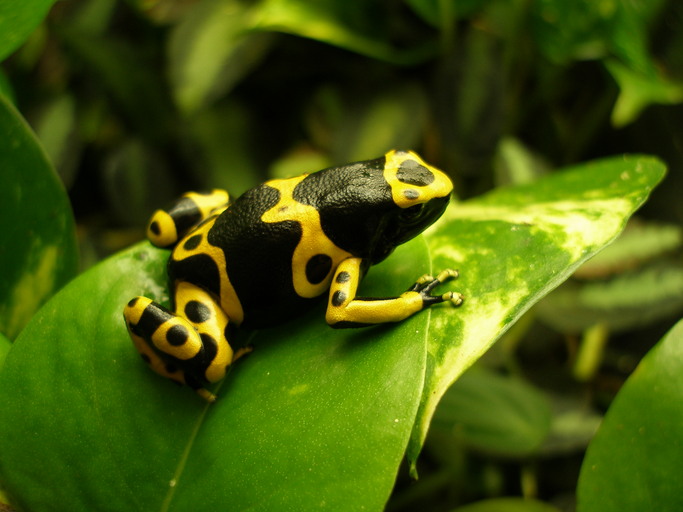
Dart Frog courtesy of Devin Edmonds
Almost every day, Facebook friends post on my timeline or the Frogs Are Green page, or Tweet at us about frogs and/or the environment.
I’m sharing this because it was six years ago this May that I founded Frogs Are Green, and so many people laughed at this cause. They’d say, “Frogs? … Who’s going to care about frogs?”
I’m happy to tell you that in six years we have reached over a million people. Each month we have 13,000 visitors who look at more than 32,000 pages, which gives us an amazing bounce rate of 1.8 %. Yes, that is not a misprint, we have a 1.8% bounce rate. These stats have been holding steady for years and are again on the rise.
We didn’t used to post on Facebook, Google+, LinkedIn (groups) and Twitter every day, but in 2014 we made a commitment to do so and reach more people than ever.
As the above story shows, our mission is working. Awareness really begins to catch fire when others know you so well that they support and advance your campaign goals without hesitation.
It all comes from zeroing in on a niche and being consistent by sharing every day. By being “top of mind” on a particular thing that’s so different, so unique, they just see frogs and think of Frogs Are Green.
10 Tips for building your nonprofit’s awareness and following
- Make sure that your website (the nucleus of your online presence) is 100% on target in expressing your mission and goals. On your homepage be brief and entice, don’t overwhelm with too many calls to action. Make sure your brand and mission are crystal clear. Be sure you are blogging and/or adding new, valuable content consistently.
- Be sure when you blog, post, or tweet, you are adding an appropriate and eye-catching photo that will prompt others to share it, not just “like” it.
- Be sure you are using #hashtags but don’t go crazy with them, lest no one will see or read your post… (I see this a lot on Instagram; so many hashtags I can’t find the message!)
- Don’t try to sell all the time with posts/tweets about buying products, classes or donating to your cause. Once in a while is all right, but you will really build your audience by sharing significant information. As they move around your website reading articles they will come to respect your efforts and just may click that donate button on their own.
- Your “competition” organization is your friend. Remember, you are both trying to help others, save wildlife and the environment, and so those that follow those other organizations may follow you too! Be kind and retweet.
- If you are planning to boost or advertise, make sure you are being selective about the information and target audience. Do your homework and know where your target is, both online or offline.
- Remember that your target audience can be in many different places. Be sure to review your Google Analytics each week and identify if what you are doing is working. For example, if you are spending most of your social media time on Facebook but when you look at your stats you have more people visiting your site from Twitter, you should tweet more often than you are!
- People consume content in many different ways, so be sure you are creating video for YouTube, audio for Podcasting, Powerpoint (for Slideshare or LinkedIn), photo galleries on Flickr, Pinterest and Facebook, blog posts that can embed these other media files, graphic images, and more… (and then share across social sites).
- When you have new media to share, don’t post on every social site at the same time and then not post for a week until the next post. Schedule different places each day so your content is circulating all the time.
- Be sure to alert the local media about events and other important news so that they can write about you. If you don’t tell them yourself, how do you expect them to know? Publicity helps awareness and begets more publicity.
Frogs Are Green was fortunate to interview Robin Moore on a podcast also. Listen here >> Robin Moore
By: frogs are green,
on 4/1/2015
Blog:
Frogs Are Green
(
Login to Add to MyJacketFlap)
JacketFlap tags:
biodiversity,
Salamanders,
Environmental Health,
People Helping Frogs and Toads,
Frog People,
Creating a Wildlife Friendly Backyard,
The Wandering Herpetologist,
Sara Viernum,
Herps Alive,
Keith Gisser,
Amphibian & Wildlife Bloggers,
Ambystoma mavortuim melanostictum,
Blotched Tiger Salamander,
Klamath Falls,
Matt Ellerbeck,
Salamander Man,
Salamanders in Oregon,
tiger salamanders,
Add a tag
This report comes from Frances in Southern Oregon.
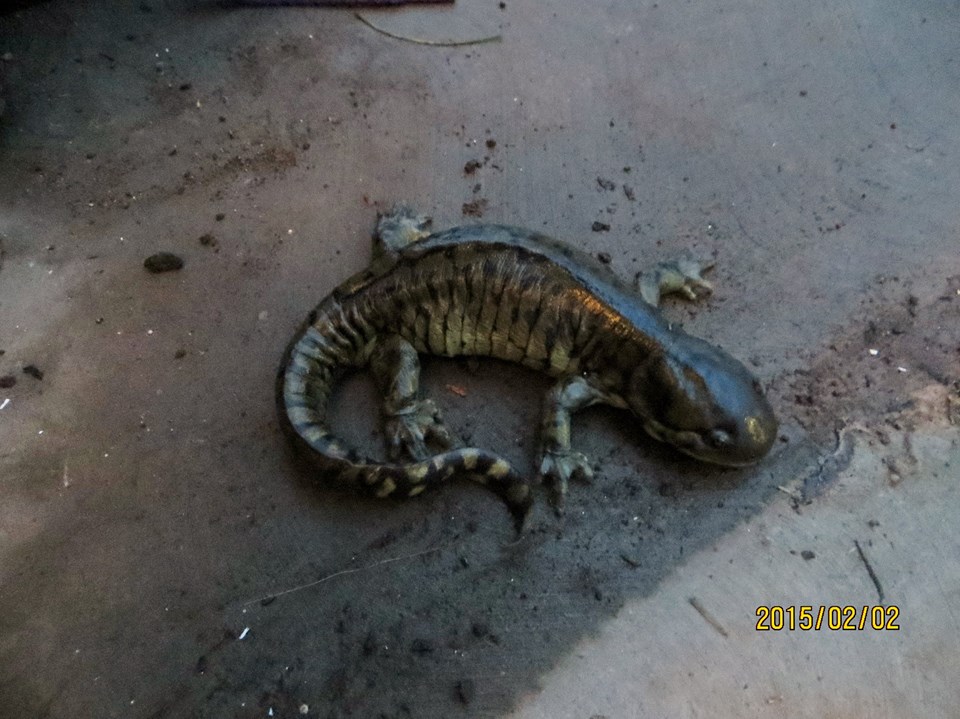
My two year old pond seems to have attracted these salamanders. I am in Southern Oregon, near Klamath Falls, and on the California border. I have been told they are Tiger Salamanders, but they do not have any bright coloring.
They are mottled and striped, and the largest one I have seen in my leaf trap was about 14″ long. The pond is about two and a half feet deep, so I can’t see how many there are, and if there are any of my goldfish left. Some of the fish were about 6 – 8 inches long when I last spotted them in late summer.
The salamander in the photo was on my driveway in early February of this year. I am pretty sure they are eating all the frogs we had. I am not hearing any croaking, and the two that frequented the rim of my hot tub are not around now. I am not sure if there is anything that can be done to balance things a bit, or if some of them are becoming permanent pond dwellers and not losing their gills, as I understand happens sometimes. Do you have any suggestions or ideas? Thank you. If these are some kind of hybrid, I don’t know how good they are for the environment.
*******
I sent this query along to a few experts and here are their responses:
Matt Ellerbeck – The Salamander Man says:
Your email/inquiry about salamanders was forwarded to me from Susan Newman at Frogs Are Green.
The salamander in the photo you sent is indeed a Tiger Salamander. They are variable in color, so if you Google searched them, it is possible that you came across images that didn’t resemble this individual salamander. Tiger Salamanders are native to Oregon so pose no environmental threat. On the contrary, salamanders are indicators of a healthy environment!
You also mentioned some concern for your frogs. Tiger Salamanders may occasionally take frogs, however, they primarily feed on insects and invertebrates. In fact, Tiger Salamander tadpoles (or larvae) prey on mosquito larvae and therefore help keep the number of these pests down! As such, I wouldn’t consider them a real threat to the frogs.
Due to the benefits they provide I hope you will accept the presence of these salamanders. If you want to learn about things you can to do help them (as they are both amphibians such efforts will also benefit frogs too) please visit the following: Save The Salamanders – How You Can Help
*******
I asked Matt why the frogs may have disappeared?
He replied:
Frances mentioned she didn’t hear the frogs croaking – perhaps the frogs are indeed still around but merely not singing at this time. I believe most frogs sing seasonally, or only at certain times. I have a backyard pond with frogs, and sometimes I may not see them for days on end, and suddenly they will reappear.
I have also read that cats will kill frogs, so they, or other predators (birds, snakes), may have taken them.
These are all plausible causes, however, I can’t say for certain. The reality is, any backyard pond (whether natural or human-man) that has animals in it will also attract various predators.
*******
Keith Gisser, Herpetologist and founder of Herps Alive! says:
Blotched Tiger Salamander. Pretty dull-colored animal normally compared to other (sub)species.
While pretty voracious eaters, rare (in my experience) for them to eat frogs or fish (although they will eat fish when in larval form) – they prefer invertebrates.
*******
Sara Viernum, Founder of The Wandering Herpetologist says:
Agreed! It’s a Blotched Tiger Salamander (Ambystoma mavortuim melanostictum). There is a small, known population (native) in southern Oregon near the border. Like all tiger salamander species these will eat anything that fits in their mouths including invertebrates, lizards, mice, snakes, frogs, tadpoles, small fish, and other salamanders. Since they are a native predator in your area they may initially cause a decrease in the local frog population but once they become established in your pond their numbers will most likely balance out with the frogs.
This site has some good info about the western tiger salamander group. California Herps – Salamanders
By: frogs are green,
on 3/23/2015
Blog:
Frogs Are Green
(
Login to Add to MyJacketFlap)
JacketFlap tags:
Add a tag
The water in your garden pond is very sensitive to change. Depending on a number of factors, a pond can soon go from crystal clear to pea soup without any apparent explanation. You will quickly learn that pond pollutants can hide in the clearest water.
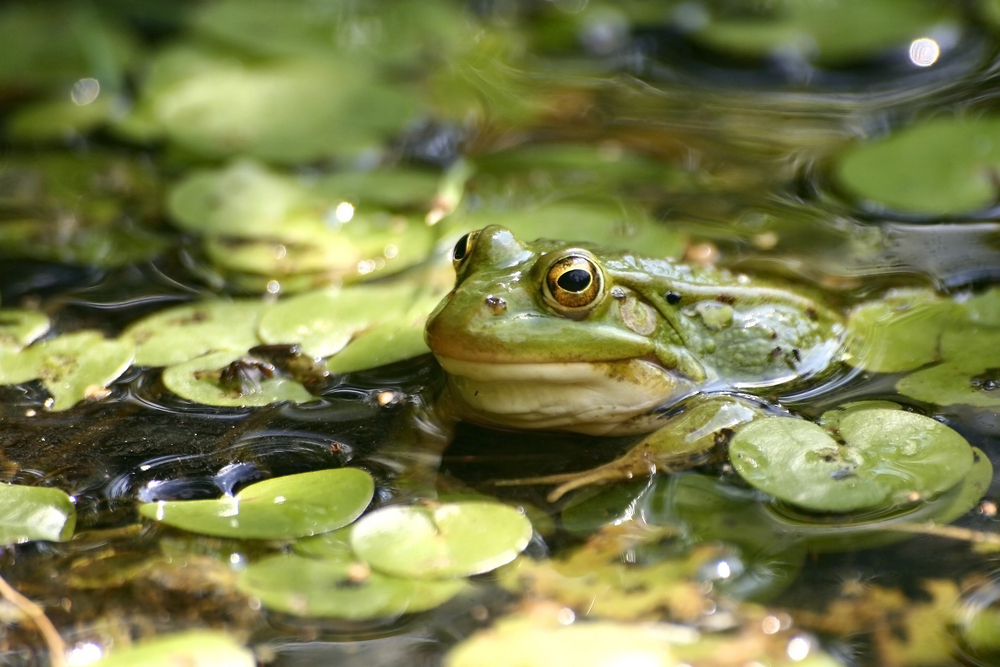
Filtration
An easy first step to ensuring a healthy pond environment is the use of a good filter and you should contact a specialist retailer, like Swell UK, who can advise you on the best solution. Biological filters will break down harmful toxins, like ammonia from fish waste, so they can be either removed or absorbed by the plant life in your pond. A UV filter will also help keep green water and algae at bay and keep down the levels of bacteria that could be harmful to the life in your pond.
A good water balance
High nitrate or pH levels in your pond can bring about the most common pond problem: algae. Algae can cause havoc in ponds, keeping light and oxygen from the plants and animals that need them. Regular testing should be carried out to keep on top of the environment in the water before an algae problem breaks out. You can pick up kits for any potential problem from online stores like Swell UK. These give you the all important heads-up you need to take action.
A key part of maintaining the right water balance is ensuring you use a good liner that will not only resist damage but ensure any outside nitrate sources, like fertilizer, are prevented from seeping through.
Oxygen
Oxygen plays a vital role in ensuring the good health of your pond. Without oxygen, certain bacteria found towards the bottom of ponds will begin to produce acids and toxins that will harm the fish, insects and helpful bacteria that may live in your pond. By planting particular oxygenating plants, you can create a natural balance of oxygen levels, but only during the day. By making use of an air pump or any water feature that will disturb the water surface, you can maintain a good oxygen level throughout the day, protecting the well being of your pond.
By: frogs are green,
on 3/22/2015
Blog:
Frogs Are Green
(
Login to Add to MyJacketFlap)
JacketFlap tags:
Contests,
Frog Art,
biodiversity,
Learn about Frogs,
Children and Nature,
frog exhibits,
Environmental Health,
Frog Conservation,
Frogs Are Green contests,
People Helping Frogs and Toads,
Frog People,
Deforestation and frogs,
Climate change and frogs,
Deforestation and amphibians,
Kids Art Contest,
Teaching Kids about Frogs,
Frogs Are Green kids' art contest,
Climate change and the Environment,
Frogs in the Classroom,
Green Dream,
A-Z Frogs,
Frogs and Artists,
Amphibian Education Programs,
58 gallery on coles street,
artwork on pollution,
student artwork of jersey city,
student frog art,
young artist,
young environmental artist,
Add a tag
The young artist’s family and friends step out the cab and walk into the gallery one by one, parents and children of different ages. They begin looking and move down the wall, admiring the variety of each artwork. The young artist turns and as she walks across the gallery I see a shy smile across her lips. Yes, she has spotted her own artwork and moves closer to see it. I ask her if I can take her photograph with her artwork and she agrees. Her family takes pictures also.
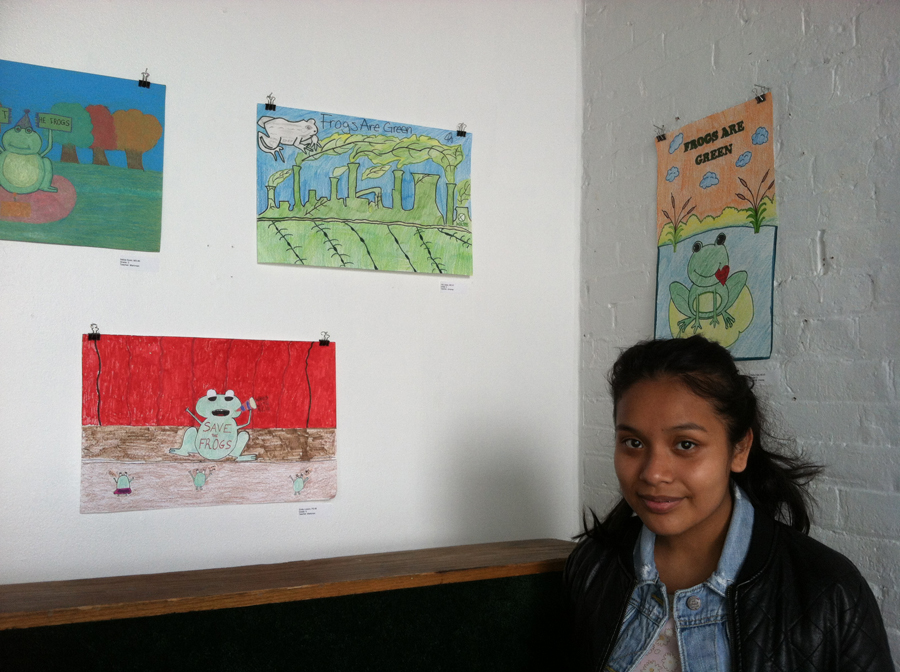
We have a conversation about whether she had a lesson in school about frogs and the environment before she did her artwork (statement) on pollution. She tells me that she did some research but just created this based on her own imagination.
It’s a wonderful and sometimes strange feeling when one sees their artwork hanging on a gallery wall. For an artist, it’s what we all dream of. Visibility and the opportunity to share what we think.
As we’re talking, I see the parents and the other children moving around the gallery discussing the other works and taking photographs that will hopefully be shared with the extended family and perhaps on social media.
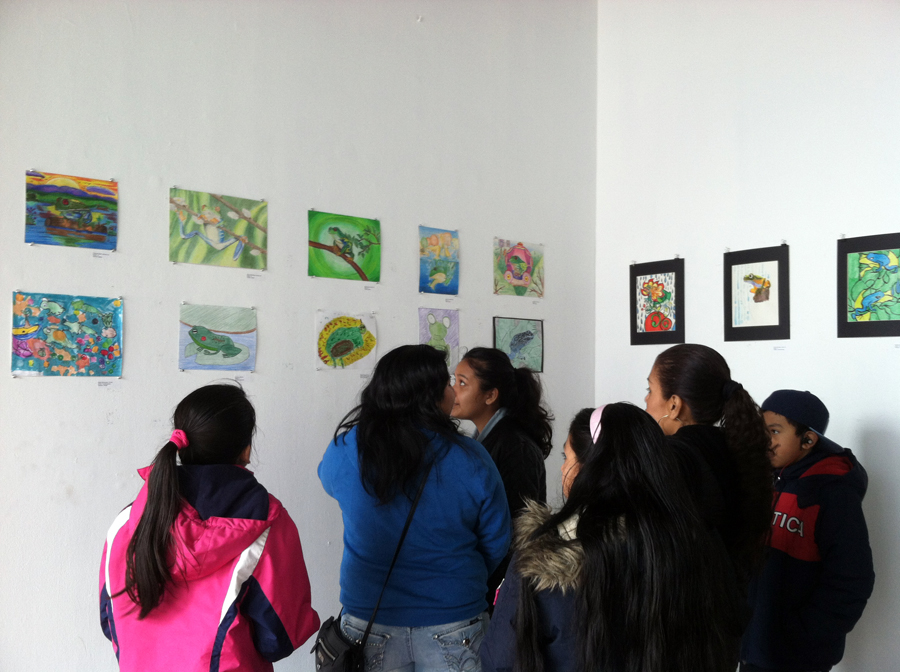
The youngest of the children takes me around to show her favorite pictures and why. She’s about 4 years old and drawn to the cutest and friendliest of the pictures.
They all say how much they enjoyed the exhibition and will be sure to do more frog art next Fall.
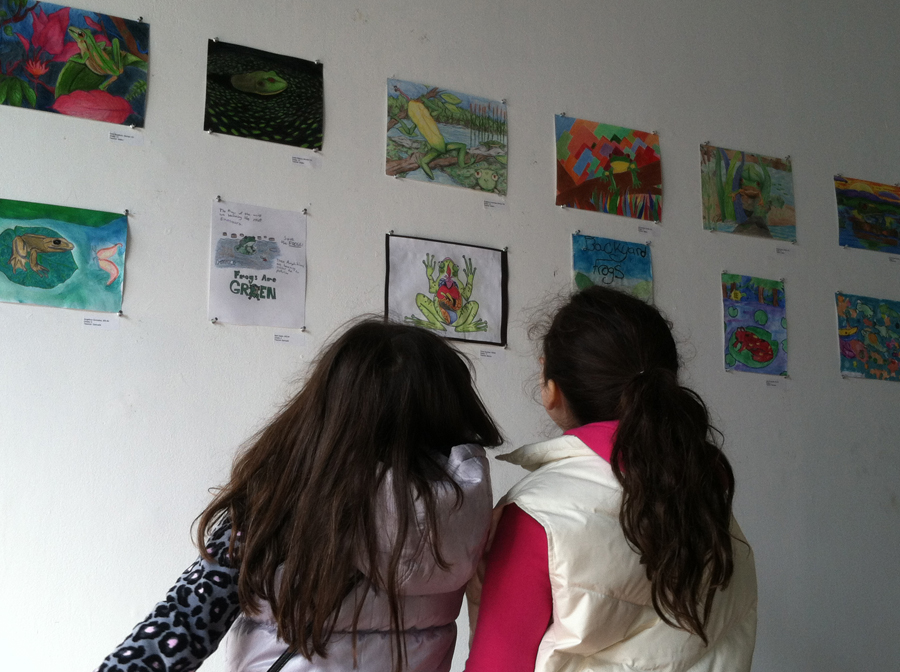
During the afternoon parents and children come by to see the student artworks but some people walk through the gallery on their way to a separate destination and do not even look at the walls, as if there is nothing there.
This baffles me and makes me wonder if there are some artists who think only their art is what’s important. Isn’t being an artist about appreciating self-expression, both your own and others?
Do seasoned artists think that because they are at a certain level of success, a young artist’s vision is of no consequence? Aren’t their artworks worth a look?
I believe that every person has the right to be seen and heard.
Having an appreciation of the arts (in its various forms, from dance and opera, to fine art and yes student frog artwork too) means stepping out of your own little world of self-expression and seeing what others have to say too.
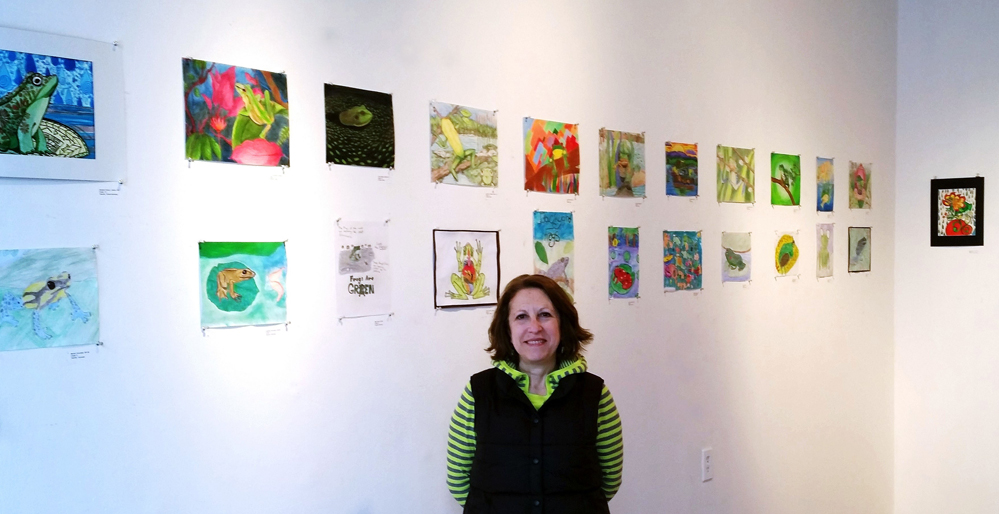
By: frogs are green,
on 3/16/2015
Blog:
Frogs Are Green
(
Login to Add to MyJacketFlap)
JacketFlap tags:
Learn about Frogs,
frog calls,
Frog People,
spring peepers,
wildlife photography,
Turtles and Terrapins,
Photographing Frogs and Toads,
Wes Deyton,
Turtles and Swamp Creatures,
Harris Lake North Carolina,
Last Mile Photography,
Painted Turtles,
peeper with full vocal sac,
peeper with retracting vocal sac,
Add a tag
Here in New Jersey the wind still roars, but in North Carolina, wildlife photographer Wes Deyton shares the Spring Peepers and Painted Turtles that are in view now that it’s warming up.
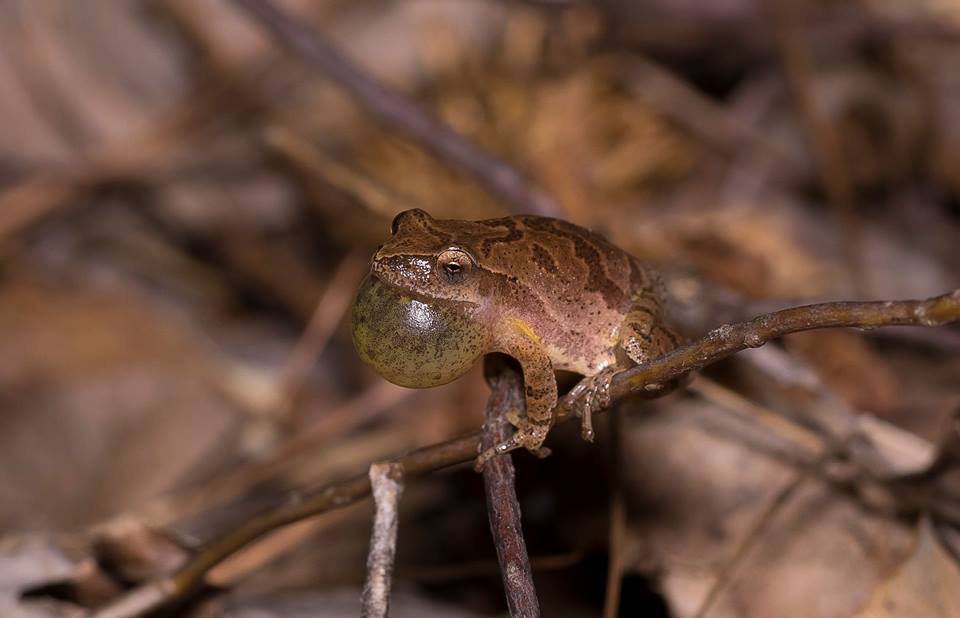
Spring Peeper with full vocal sac by Wes Deyton
As you can see from the photo above, the Spring Peeper has a fully extended vocal sac for calling, but as Wes came in closer, it began to retract.
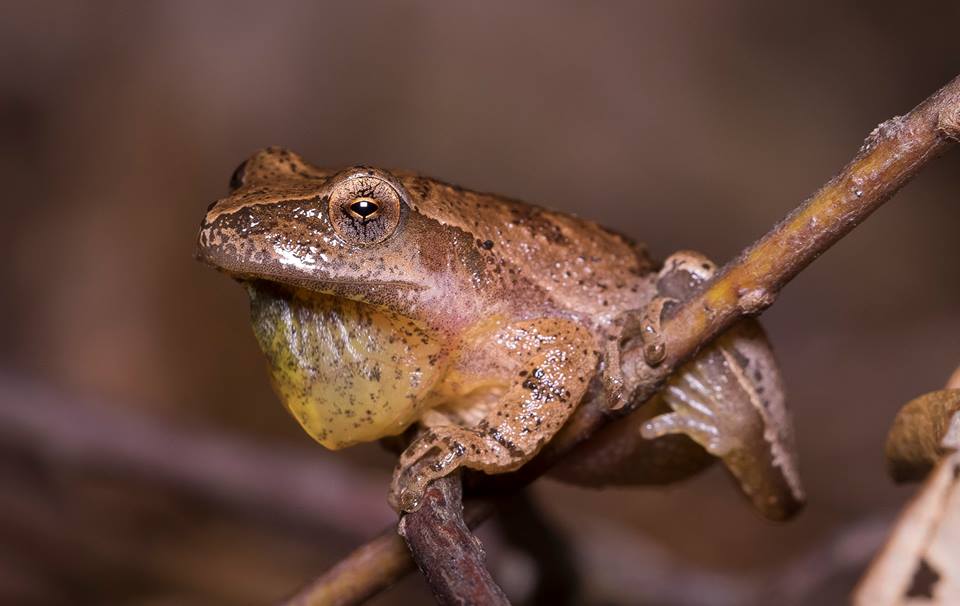
Spring Peeper with retracting vocal sac by Wes Deyton.
Also at Harris Lake in North Carolina are Painted Turtles.

Painted Turtle at Harris Lake in North Carolina, by wildlife photographer Wes Deyton
Learn more about Spring Peepers here: Celebrating Spring Peepers
and Frog Call of the Week: Spring Peepers
Click to see more of >> Wes Deyton’s wildlife photography
By: frogs are green,
on 2/27/2015
Blog:
Frogs Are Green
(
Login to Add to MyJacketFlap)
JacketFlap tags:
Amphibian research,
Climate change and the Environment,
A-Z Frogs,
Fungal infections in wildlife,
amphibian chytridiomycosis,
amphibian epidemic,
Current Biology,
Dr. Dirk Schmeller,
Dr. Franco Andreone,
Elodie Courtois,
Frank Pasmans,
high altitudes,
Prof. Miguel Vences,
TU Braunschweig,
UFZ,
Madagascar,
biodiversity,
Learn about Frogs,
Environmental Health,
Frog Conservation,
Frogs and the Rainforest,
People Helping Frogs and Toads,
Frog People,
Deforestation and frogs,
Amphibian habitat loss,
Climate change and frogs,
Amphibian Survival Alliance,
Deforestation and amphibians,
chytrid fungus,
Chytrid disease,
Add a tag
The entire amphibian class is currently afflicted by a global pandemic that is accelerating extinction at an alarming rate. Until now, a few islands like Madagascar were thought not to have been affected. However, an analysis of the latest series of tests shows that the chytrid fungus also poses a threat to amphibians in Madagascar. “This is sad news for herpetologists around the world,” says Dr. Dirk Schmeller of the UFZ, who was involved in analyzing the samples and has, together with Elodie Courtois, detected Bd in samples from Madagascar collected in 2010. “Firstly, it means that an island that is home to a particularly high number of amphibian species is now at risk. Several hundred species live only on this island. And, secondly, if the pathogen has managed to reach such a secluded island, it can and will occur everywhere.”
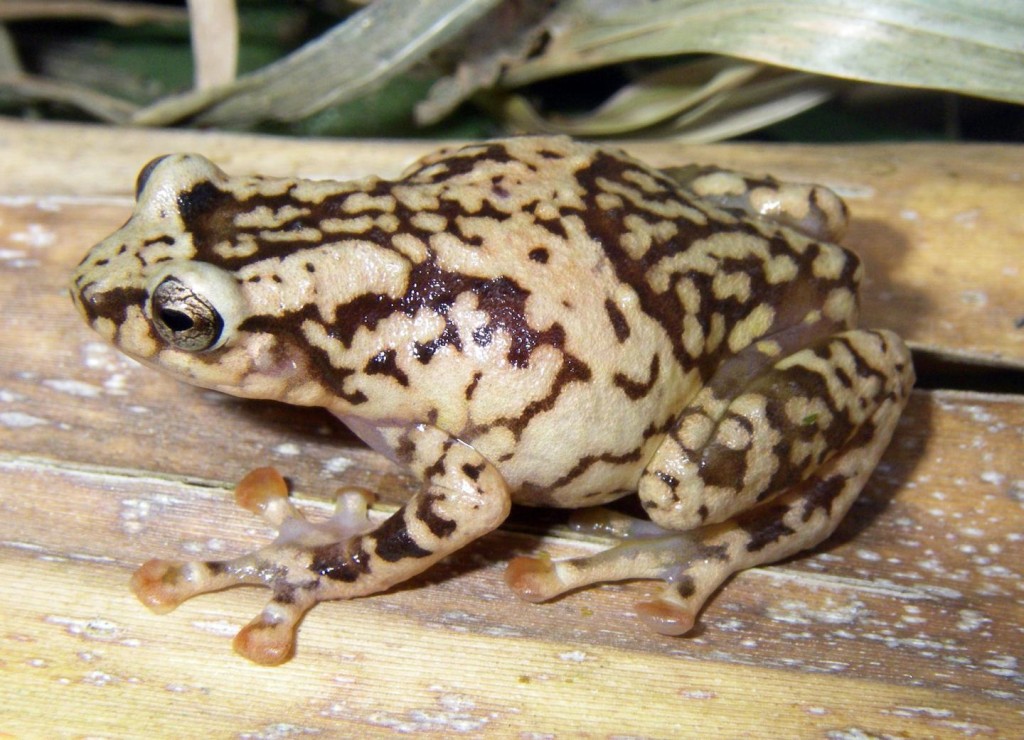
IMAGE: Chytrid fungus was proved on Platypelis pollicaris from Ranomafana. view more
Credit: Miguel Vences / TU Braunschweig
Prof. Miguel Vences from TU Braunschweig adds, “The chytrid fungus was found in all four families of the indigenous Madagascan frogs, which means it has the potential to infect diverse species. This is a shock!” The study also shows that the disease affects amphibians at medium to high altitudes, which ties in with observations from other parts of the world, where the effects of the amphibian epidemic have been felt primarily in the mountains.
“Luckily, there have not yet been any dramatic declines in amphibian populations in Madagascar,” Dirk Schmeller reports. “However, the pathogen appears to be more widespread in some places than others. Madagascar may have several strains of the pathogen, maybe even the global, hypervirulent strain. This shows how important it is to be able to isolate the pathogen and analyze it genetically, which is something we haven’t yet succeeded in doing.” At the same time, the researchers recommend continuing with the monitoring program across the entire country to observe the spread of the disease. The scientists also suggest setting up extra breeding stations for key species, in addition to the two centers already being built, to act as arks, so that enough amphibians could be bred to recolonize the habitats in a crisis. “We are also hopeful that we may be able to suppress the growth of the Bd pathogen with the help of skin bacteria,” says Miguel Vences. “It might then be possible to use these bacteria as a kind of probiotic skin ointment in the future.” A high diversity of microbial communities in the water could also reduce the potential for infection, according to earlier investigations conducted by Dirk S. Schmeller, Frank Pasmans, and their teams (published in Current Biology).
The outbreak of amphibian chytridiomycosis in Madagascar puts an additional seven per cent of the world’s amphibian species at risk, according to figures from the Amphibian Survival Alliance (ASA). “The decline in Madagascan amphibians is not just a concern for herpetologists and frog researchers,” says Dr. Franco Andreone, “It would be a great loss for the entire world.”
Guest post by Dr. Dirk Schmeller
Originally published:
http://www.eurekalert.org/pub_releases/2015-02/hcfe-acf022615.php
By: frogs are green,
on 2/8/2015
Blog:
Frogs Are Green
(
Login to Add to MyJacketFlap)
JacketFlap tags:
biodiversity,
Learn about Frogs,
How You Can Help,
habitat loss,
Children and Nature,
Environmental Health,
People Helping Frogs and Toads,
Chemicals in the Environment,
Amphibian habitat loss,
Climate change and frogs,
frogs as bioindicators,
Chytrid disease,
Creating a Wildlife Friendly Backyard,
Amphibian research,
Frogs and Medicine,
Climate change and the Environment,
A-Z Frogs,
wildlife conservation,
Sustainable Choices,
Fungal infections in wildlife,
Amphibian Education Programs,
protecting environment,
agroecosystems,
bolivian amphibian initiative,
frogs and water quality,
learning frog science,
pH water quality,
redmond WA,
tadpoles health,
water quality,
Add a tag
Yesterday, in class with the Cloud Institute and Sustainable Jersey (NJ Learns), each student got to briefly share their project, so I was describing the Frogs Are Green mission and projects on the agenda for 2015.
My teacher Jaimie P. Cloud, challenged me with this question. “Much of what Frogs Are Green is about is bringing awareness to the public, but is there a change I want in the public’s behavior?”
It made me think about one specific area that we can focus on which would help frogs and amphibians as well as other wildlife and humans, and that is water quality.
We know that there are many issues, such as, pollution and oil spills, pesticides and other toxins, pharmaceuticals, and these aren’t just affecting wildlife, but us as well. It’s humans that are creating many of these problems, so it’s obvious that we must be the ones to correct it.
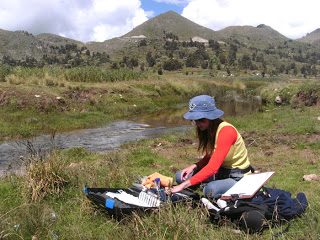
I did a search on Google for Frogs and Water Quality and was surprised to learn there is currently no standard for water quality as it applies to frogs and amphibians:
“The factors thought to be contributing to declines in frog populations include habitat loss, introduction of exotic species, overexploitation, disease, climate change, and decreasing water quality. With respect to water quality, agroecosystems use 80-90% of the water resources in the western United States, frequently resulting in highly eutrophic conditions. Recent investigations suggest that these eutrophic conditions (elevated pH, water temperature, and un-ionized ammonia) may be associated with frog embryo mortality or malformations. However, water quality criteria for frogs and other amphibians do not currently exist. Here, we briefly review data that support the need to develop water quality parameters for frogs in agroecosystems and other habitats.”
(from this website: PMC1519110/http://www.ncbi.nlm.nih.gov/pmc/articles/PMC1519110/)
What this tells me is that currently the water quality is tested to make sure it’s safe for humans, but there are no regulations in place for it to be safe for wildlife? Doesn’t it matter that it’s healthy for all life?
I’ll be reading much more on this issue and would like to invite you to share your thoughts or links to additional documentation you may have found.
Here’s a video I’d like to share because it shows just how important it is to educate the young with hands-on education from Marie Hartford, Science, 5th Grade Teacher and her students in Redmond, WA on the Teaching Channel about “Measuring the pH as it Relates to Water Quality.”
By: frogs are green,
on 1/22/2015
Blog:
Frogs Are Green
(
Login to Add to MyJacketFlap)
JacketFlap tags:
Learn about Frogs,
How You Can Help,
Children and Nature,
Environmental Health,
Frog Conservation,
People Helping Frogs and Toads,
Frog People,
Living a Frog-Friendly Life,
Read about Frogs,
Literary Amphibians,
frog gifts,
Frog fun,
Teaching Kids about Frogs,
Frogs in the Classroom,
nature books for kids,
Eco Interviews,
Sustainable Choices,
Children's Books on Frogs,
Frogs and Artists,
Amphibian Education Programs,
Amphibian & Wildlife Bloggers,
children's author on frogs,
frog book author,
frog stories,
Irwin Qaugmire,
Irwin Quagmire Wart,
protecting environment,
protecting frogs and wildlife,
Add a tag
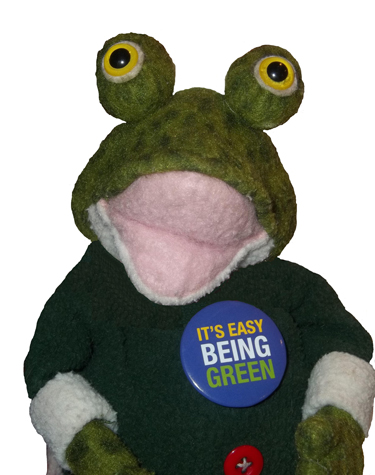 Please introduce yourself and tell us a bit about your mission and goals.
Please introduce yourself and tell us a bit about your mission and goals.
I’m a frog so I’ve always been interested in our health and welfare. I have a baby brother and young cousins so I want to see our habitats preserved for them and for all future generations.
What is your educational background and what lead to sharing “The Land of of Lily Pad?”
I’m sorry to admit it, I have no formal education, but I’m loaded with street smarts… swamp smarts, if you prefer. Even though my name is Irwin Quagmire, lots of people know me by my initials, IQ because I am a very smart frog. I began writing books in 2011, after my first trip to France. Since then, I have written three other books, including a book on environmental stewardship for kids. After all, who knows more about being green than a frog!
Do you travel to exotic places and if yes, tell us about some of them.
The most exotic place I’ve been to is my home… Land of Lily Pad. It’s the most fabulous frog pond on earth… where humans are not allowed. So it’s still a beautiful, healthy, safe environment. Otherwise, I’ve only traveled a little in the US and Europe.
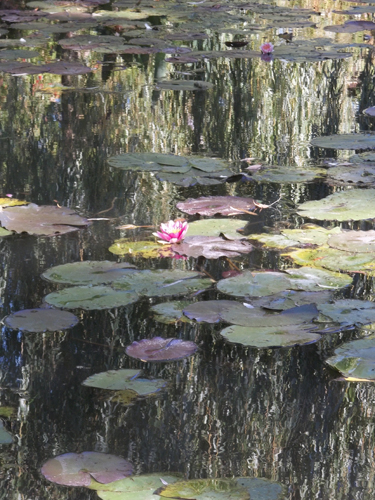
Please share your books and/or publications?
I have written, as I said before, four books:
Irwin Quagmire Wart Travels to Paris, France… a kid’s guide to the City of Lights
Irwin Quagmire Wart Travels Back in Time… a kid’s guide to life in Pioneer America
Green is Good… a kid’s guide to environmental stewardship
Perfectly Perfect – a rhyming book for young children that embraces the idea of self-acceptance and self-love no matter what you look like
What are some challenges you have faced and how did you deal with them?
I’m luckier than a lot of frogs. My family and friends have a clean, safe home. My biggest challenge is where to find the juiciest flies… all kidding aside, I am trying really, really hard to get my message out to the world and to get my books published. But it’s hard and very competitive.
What can people do to help? Donate, and contribute to your cause?
It would be helpful if my message and my website got promoted more. And it would be a dream to find a real publisher or literary agent… but I’m not holding my breath.
“Ask not what your swamp can do for you but what you can do for your swamp”… Irwin Quagmire Wart (and maybe John F. Kennedy). I believe this whole-heartedly and want to help your organization as much as I am able. I am planning on including a link to your website on mine: on the page, Irwin’s Favorite Things. If there’s more I can do, please let me know. My amanuensis can write pretty well and is very willing to contribute whatever she/we can.
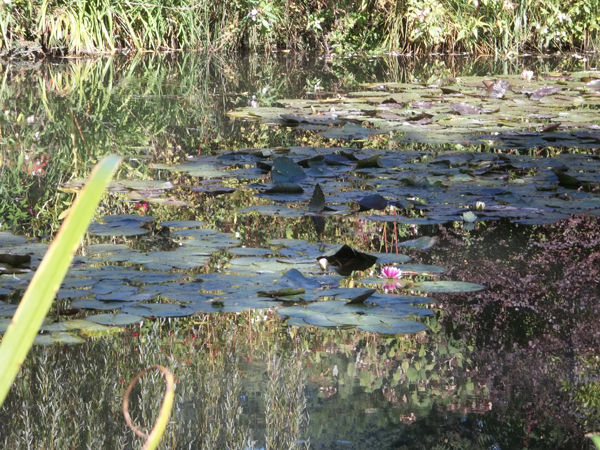
How do you reach your targeted audience?
Is it through your website, advertising or social media or another route? Which is most effective and why?
I have a Facebook page: Irwin Quagmire Wart
A website: http://www.irwinquagmirewart.com/
Twitter account: @IrwinQWart
So far, none of them are effective but I am hoping that through Twitter, and reaching out to other frogs and frog-related people, I can drive more traffic to my website… and eventually, my books.
How do you keep the audience engaged over time?
I update my website often and try to include subjects that will be of interest to kids and adults, but are also near and dear to my heart; the environment is my big passion.
Tell us about your events around the world and some of the campaigns you have started.
None yet, but I have big plans…
What is in the works for the future? What haven’t you yet tackled, but will want to do soon?
My goal is to write a series of travel books for kids, focusing on unique world locations, both large and small. I believe that through travel, both children and frogs can learn that differences in appearance and culture are both good and interesting. By helping children to “see the world” (through a frog’s eyes) as a beautiful, non-scary place filled with interesting people, beautiful art, and amazing things to see and do, I hope to make the world seem a little smaller and certainly a place that needs protecting.
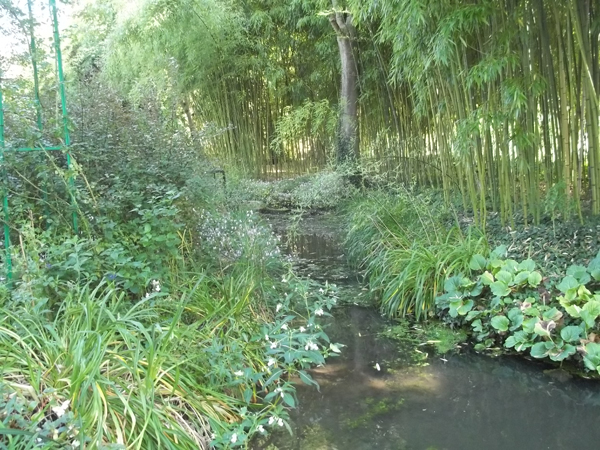
By: frogs are green,
on 1/11/2015
Blog:
Frogs Are Green
(
Login to Add to MyJacketFlap)
JacketFlap tags:
Add a tag
Thank you so much for your outpouring of “frog and environmental” love. The 5th Annual Frogs Are Green Kids Art Contest with 973 diverse artworks from 32 countries was the widest global reach yet! I want to thank my judges: Laura Skolar, Christine Wiltanger, Greg Spalenka, Greg Brickey, Derek May, Mark T. Smith, and Emma Lam.
Each 1st place WINNER in the age group categories: (3-6, 7-9, 10-12, and 13-15) win a prize, so please contact us. Other winners receive an official certificate by email, detailing where they placed, so contact us for that as well. All other children will be able to download a participation certificate via this website soon.
And now… for the Winners!
Age Group 3-6
1st Place Winner, Kardelen Koc, Turkey; 2nd Place Winner, Liam Cheng, New York; 3rd Place Winner Vinci Chan Wing Chi, Hong Kong.
Honorable Mentions: Jessen Whelchel, California; Lucy Krimmel, California; Liam Malinsky, Hoboken, New Jersey; Liu Tsz Chun, Hong Kong; Stephen Lu, South Brunswick, NJ.
Age Group 7-9
1st Place Winner, Justin Hou, New Mexico; 2nd Place Winner, Mofan Qu, South Brunswick, New Jersey; 3rd Place Winner, Grace Demarest, California.
Honorable Mentions: Aditri Chauhan, Piscataway, New Jersey; Csenge Markus, Hungary; Dhanvi Sayani, Dubai, UAE.
Age Group 10-12
1st Place Winner, Roshni K.R., India; 2nd Place Winner, Doga Tansug, Turkey; 3rd Place Winner, Ada Zeylan, Turkey; 4th Place Winner, Rana Taki, Turkey.
Honorable Mentions: Elif Ersoz, Turkey; Fatahillah Faisal Rizqiawan, Indonesia; Joshua Lim Kah Lak, Malaysia; Mercen Turkmen, Turkey; Zakiyah Hasanah, Indonesia.
Age Group 13-16
1st Place Winner, Irene Qiao, USA; 2nd Place Winner, Arushi Aggarwal, India; 3rd Place Winner, Dayanna Franco, Liberty HS, New Jersey.
Honorable Mentions: Cristina Maria Simion, Romania; Lena Sutanti, Indonesia; Lily Lu, Canada; Marian Patrisia, Romania.
Best Environmental Art
1st Place Winner, Olivia Xu, New Jersey, USA; 2nd Place Winner, Irene Qiao, USA; 3rd Place Winner, Cynthia Cao, USA.
Honorable Mention: Lena Sutanti, Indonesia.
Best Black and White Art
1st Place Winner, Sude Dogan, Turkey; 2nd Place Winner, Lee Xin Yee, Malaysia; 3rd Place Winner, Oliver Perrone, Hungary.
Best 3D Art
1st Place Winner, Ioana Vallimarescu, Romania; 2nd Place Winner, Margaret Chen, Michigan, USA; 3rd Place Winner, Alexander Franco, Jersey City, NJ.
Honorable Mentions: Dilan Sendan, Turkey; Elizabeth Manthey, Plymouth, Wisconsin; Niamh Ni Iceadha, Ireland; Trisha Sayani, Dubai, UAE.
Best Typographic “Frogs Are Green”
1st Place Winner, Afreen Kapoor, India; 2nd Place Winner, Dhanayra Lara, MS #7, Jersey City, NJ, USA.
Honorable Mentions: Angel Sealtiel S. Munoz, Philippines; Pranav Vijay Chhatbar, India.
Best of Jersey City
1st Place Winner, Reshma Modi; 2nd Place Winner, Amir Shadkam; 3rd Place Winner, Rachel Shneberg; all from Jersey City, New Jersey, USA.
Honorable Mentions: Giancarlo Quesda; Nishat Poppy; Sarah Mongare; Shane Meledathu, from Jersey City, NJ.
- Susan Newman, founder, Frogs Are Green, Inc. A NJ nonprofit organization.
By: frogs are green,
on 1/6/2015
Blog:
Frogs Are Green
(
Login to Add to MyJacketFlap)
JacketFlap tags:
Meet the Frogs,
Frogs Are Green contests,
People Helping Frogs and Toads,
Frog People,
Australian frogs,
smallest frog in the world,
Frogs Are Green Photo Contests,
Photographing Frogs and Toads,
Wes Deyton,
Keith Gisser,
2014 winners frogs in the wild,
Alyssa Bredin,
Andy Levine,
Beni Arisandi,
Chad Beranek,
Christian Spencer,
Christine Guhl,
Devin DePamphilis,
frogs in the wild photo contest,
golden droplet frog,
green and golden bell frog,
Harrisburg PA frogs,
igrid Shreeve,
Indonesian frogs,
Itatiaia National Park,
Matthew Pastick,
Megan Maloy,
Minnesota frogs,
North Carolina frogs,
Sam Skolnik Mullane,
Wildwood Park,
winners photo contest,
Contests,
frog exhibits,
Frog fun,
Add a tag
Announcing the winners of the 2014 Frogs in the Wild Photography Contest hosted by Frogs Are Green!
I want to thank this year’s judges: Sigrid Shreeve, Christine Guhl, Megan Maloy, Sam Skolnik Mullane, Alyssa Bredin, Keith Gisser, and Andy Levine.
1st Place Winner: 2014 Frogs in the Wild by Wes Deyton of North Carolina.
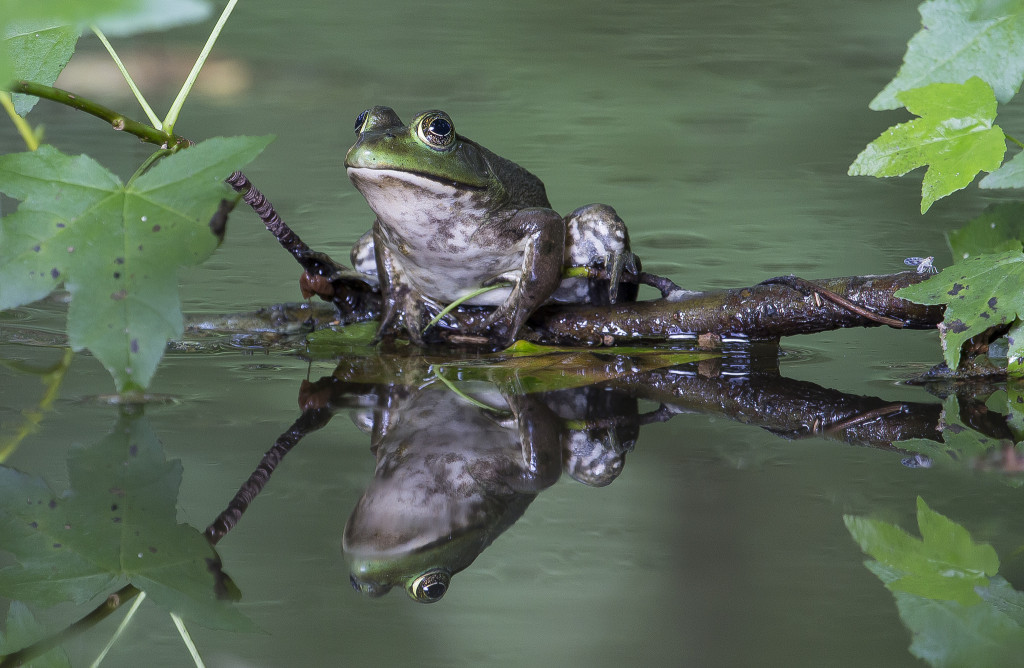
2nd Place Winner: 2014 Frogs in the Wild, Beni Arisandi with “KONG,” Sumedang, West Java, Indonesia.
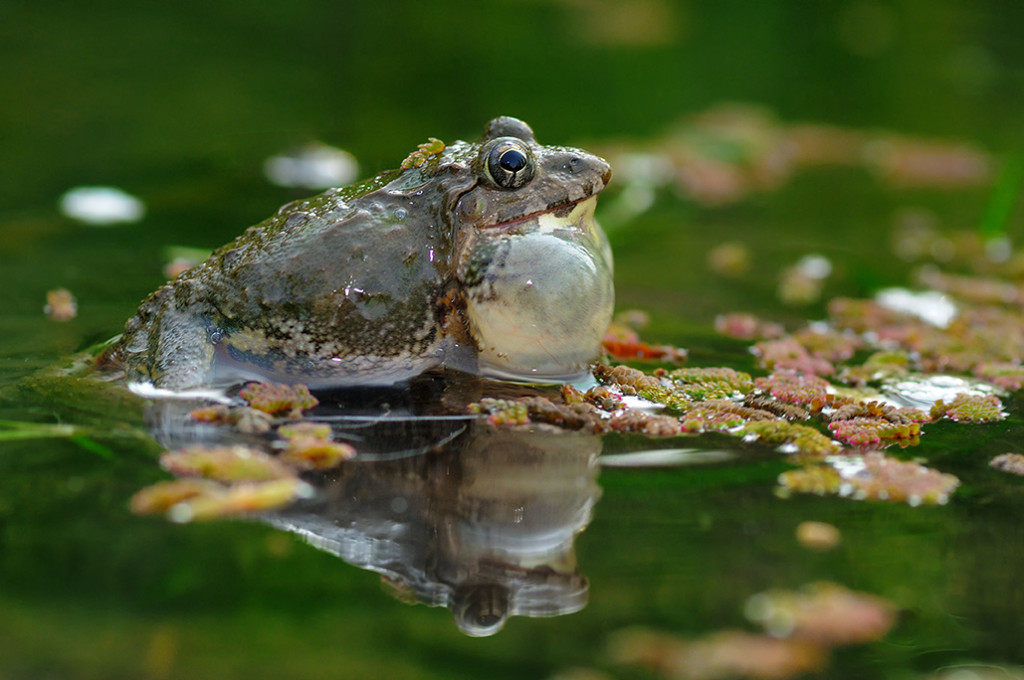
3rd Place Winner: 2014 Frogs in the Wild Golden Droplet Frog by Christian Spencer. Taken in Itatiaia National Park rio de Janerio Brasil. Brachycephalus ephippium, one of the smallest frogs in the world measuring 12mm makes signals with its arms to mark territory.
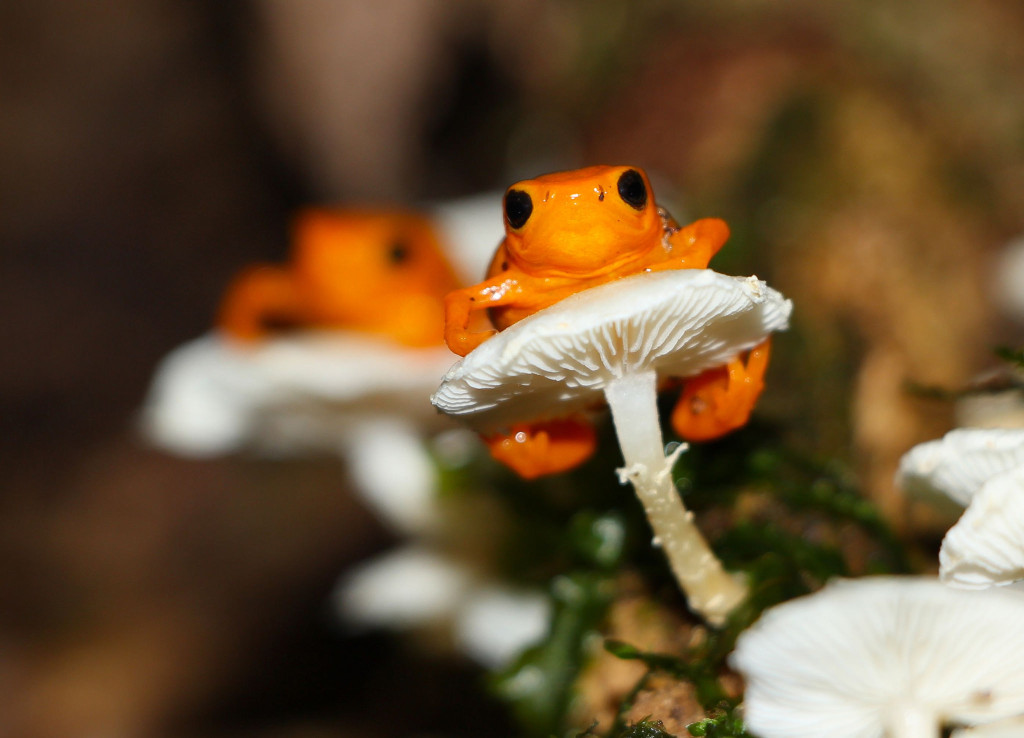
Honorable Mention: 2014 Frogs in the Wild, Frog by Matthew Pastick, Minnesota, USA.
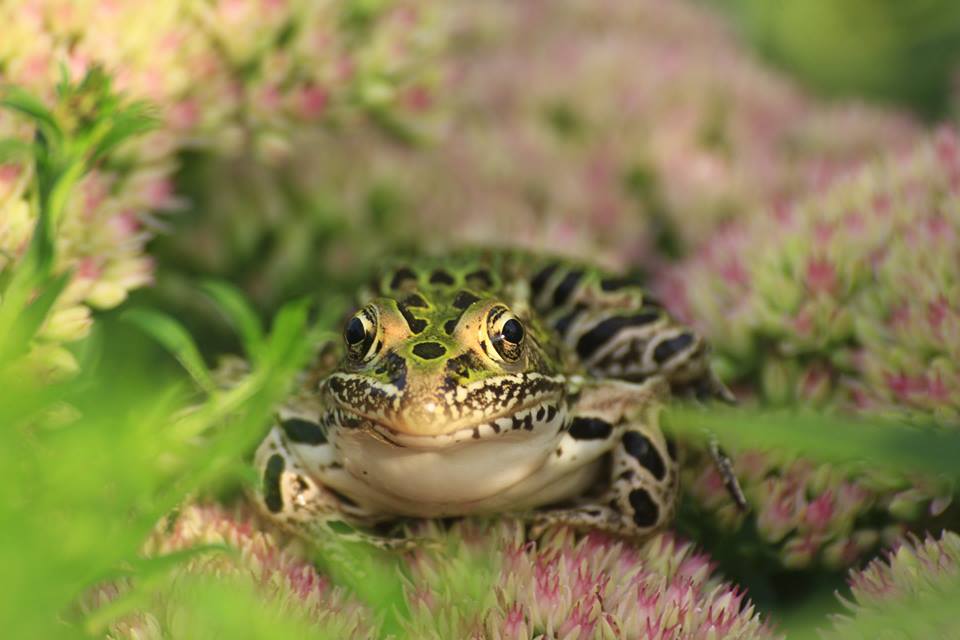
Honorable Mention: 2014 Frogs in the Wild, Devin DePamphilis, age 13 with Seeing Green at Wildwood Park, Harrisburg, PA.
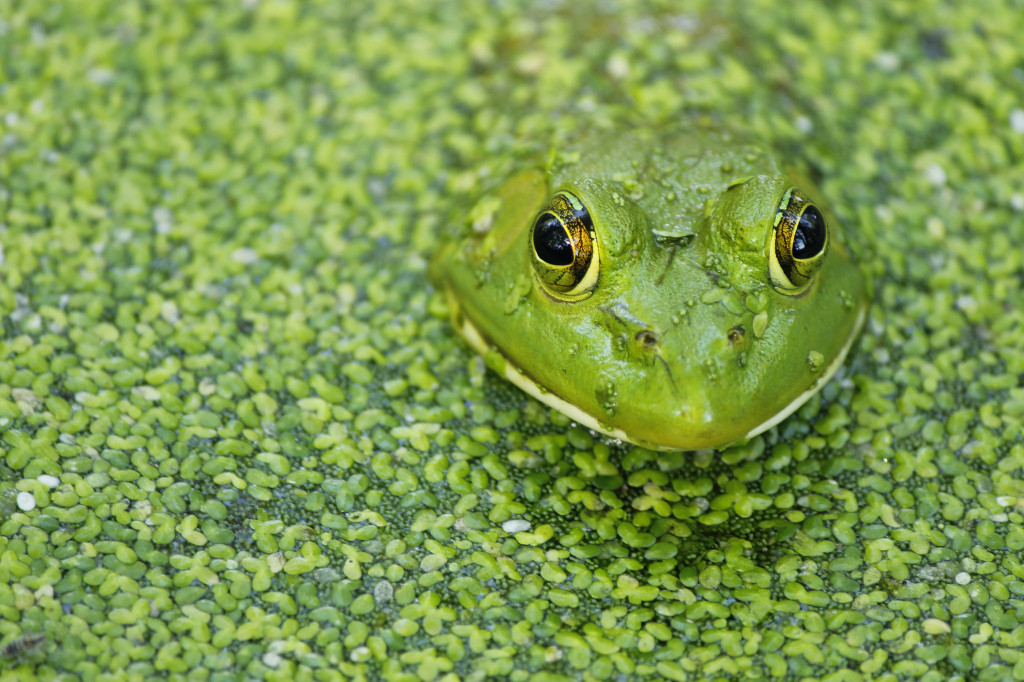
Honorable Mention: 2014 Frogs in the Wild, green and golden bell frog by Chad Beranek, Australia.
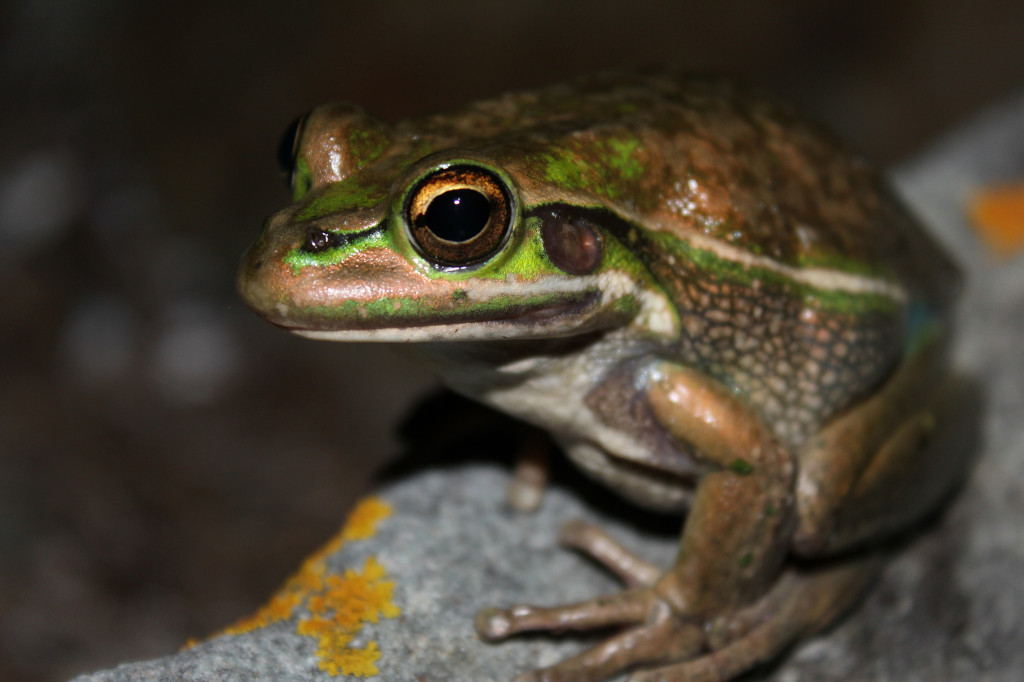
To see the 56 fabulous entries visit: 2014 Frogs in the Wild Photo Contest on Flickr.
- Susan Newman, founder and administrator of Frogs Are Green
By: frogs are green,
on 1/6/2015
Blog:
Frogs Are Green
(
Login to Add to MyJacketFlap)
JacketFlap tags:
Contests,
Frog People,
Frog fun,
Frogs Are Green Photo Contests,
Photographing Frogs and Toads,
Pickerel frog,
Wes Deyton,
Northern Cricket Frog,
Keith Gisser,
Alyssa Bredin,
Andy Levine,
Christine Guhl,
Megan Maloy,
Sam Skolnik Mullane,
2014 Winners Backyard Frogs Photo Contest,
Chela Crinnion,
Choti Singh,
common Indian tree frog,
costa rican frog,
frog in a pipe,
Mike Adamovic,
photo contest winners,
Sigrid Shreeve,
Zakiyah Hasanah,
Add a tag
Announcing the winners of the 2014 Backyard Frogs Photography Contest hosted by Frogs Are Green!
I want to thank this year’s judges: Sigrid Shreeve, Christine Guhl, Megan Maloy, Sam Skolnik Mullane, Alyssa Bredin, Keith Gisser, and Andy Levine.
1st Place Winner: 2014 Backyard Frogs, Costa Rican Frog photographed by Chela Crinnion of New York.
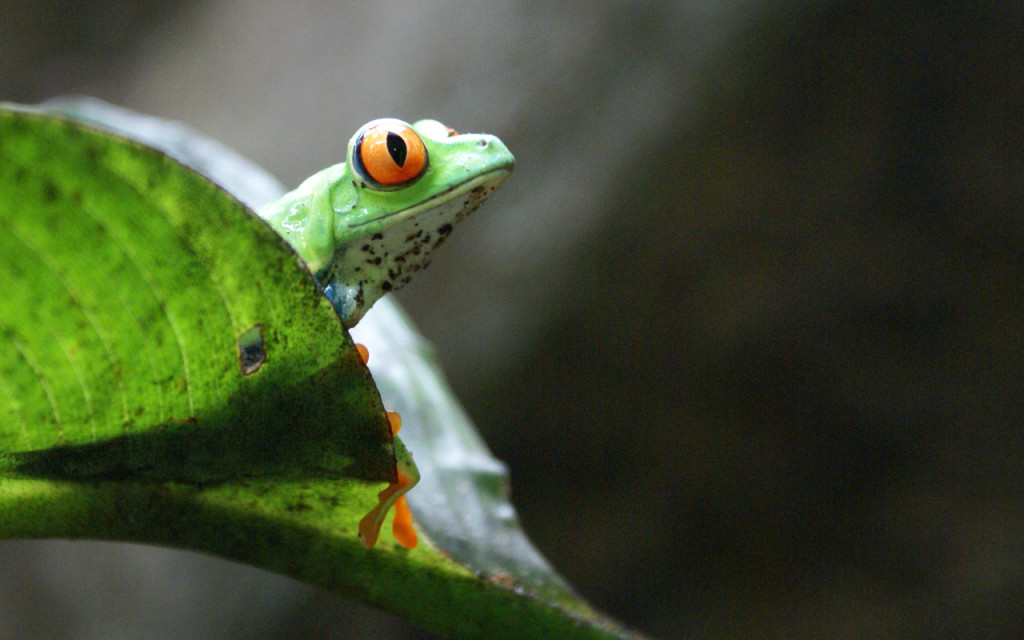
2nd Place Winner: 2014 Backyard Frogs, Northern Cricket Frog, Mike Adamovic, New York.
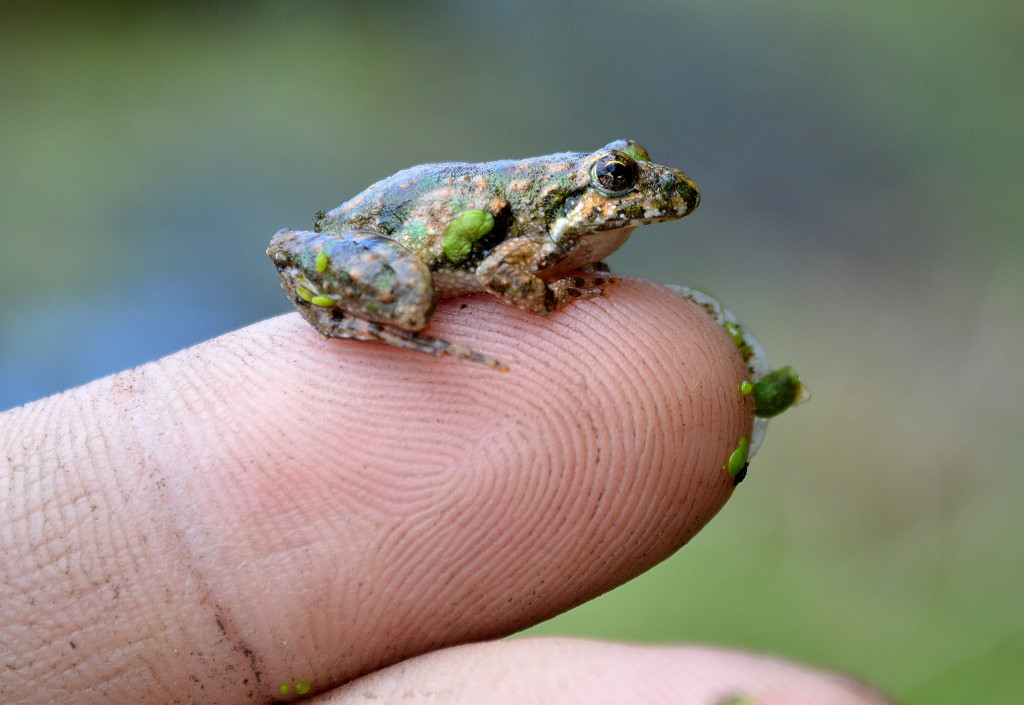
3rd Place Winner: 2014 Backyard Frogs, Common Indian Tree Frog by Choti Singh.
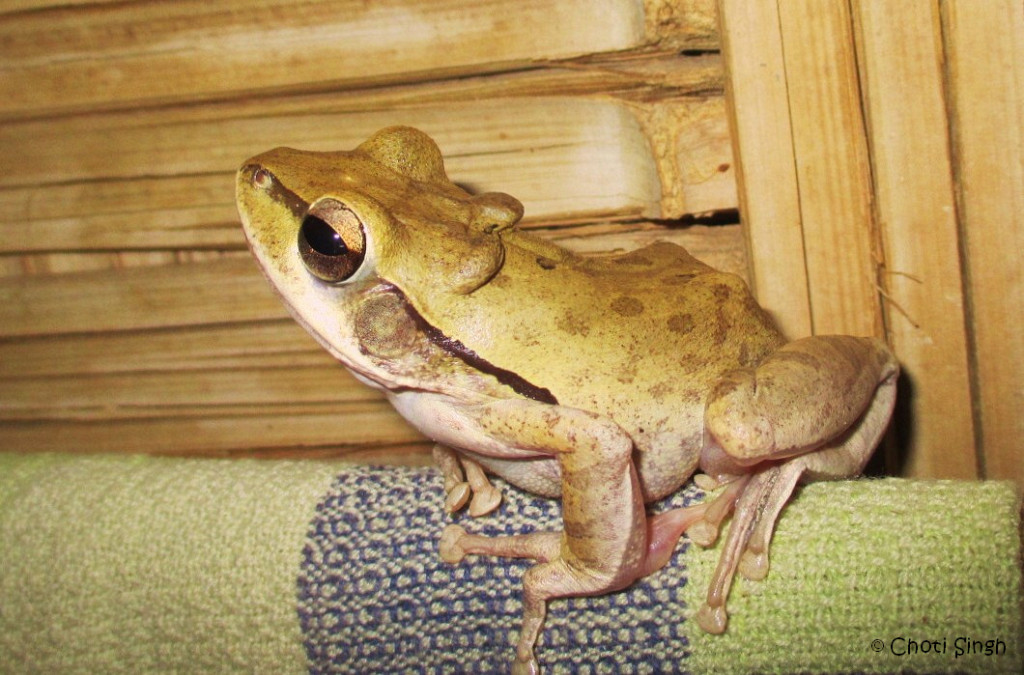
Honorable Mention: 2014 Backyard Frogs, Pickerel Frog by Wes Deyton, North Carolina.
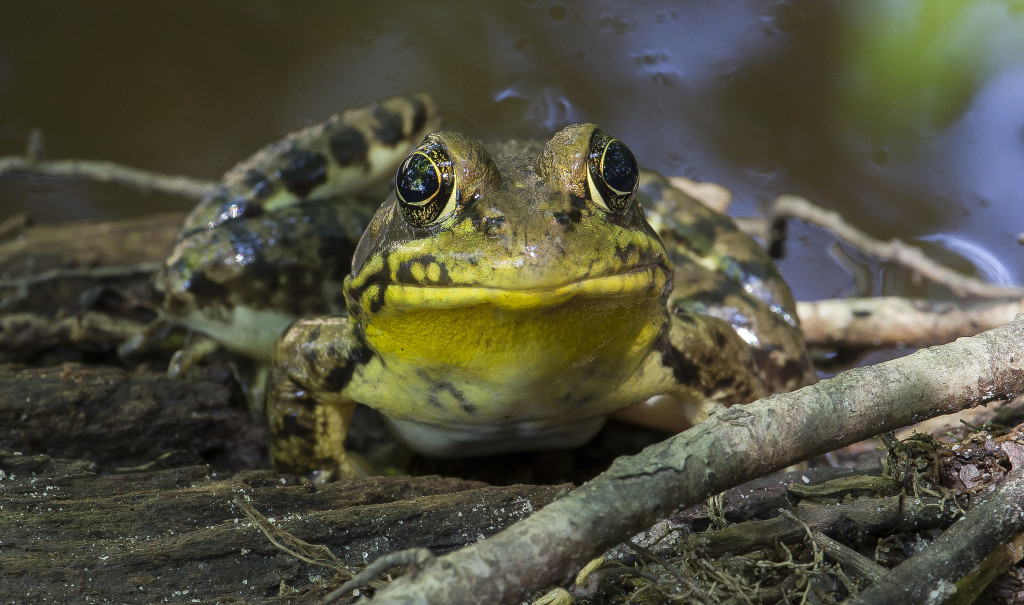
Honorable Mention: 2014 Backyard Frogs by Zakiyah Hasanah, age 10, from Indonesia with Frog in a Pipe.
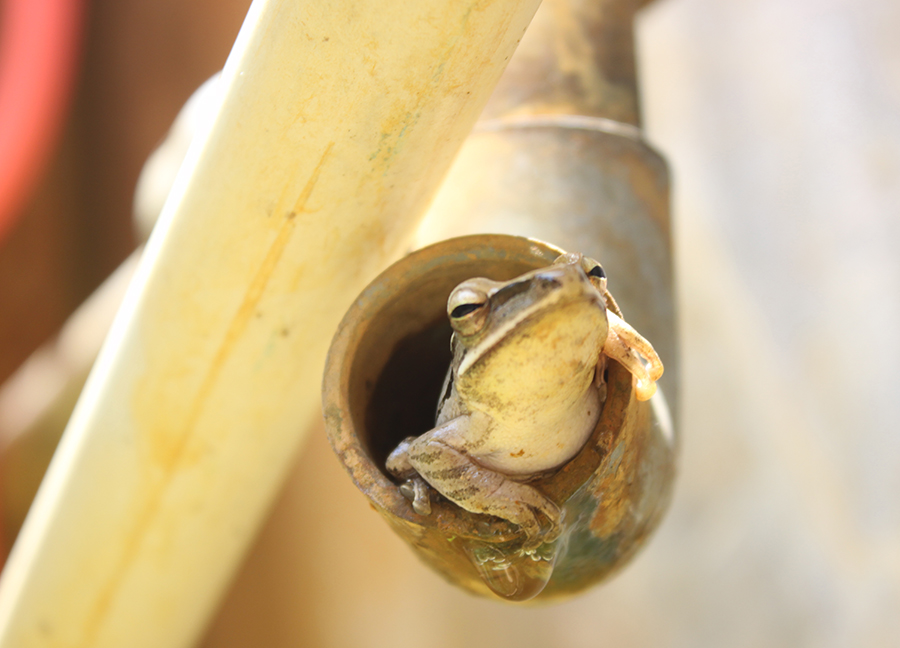
To see the entire gallery of 34 images submitted visit: 2014 Backyard Frogs Photo Contest on Flickr.
- Founder and Frogs Are Green administrator, Susan Newman.
By: frogs are green,
on 1/2/2015
Blog:
Frogs Are Green
(
Login to Add to MyJacketFlap)
JacketFlap tags:
save the frogs,
Children and Nature,
Environmental Health,
Frog People,
Read about Frogs,
Amphibian Ark,
Amphibian research,
The Wandering Herpetologist,
Very Inspiring Blogger Award,
A-Z Frogs,
wildlife conservation,
Jersey City Parks Coalition,
Sustainable JC,
Amphibian Education Programs,
The Cloud Institute,
Amphibian & Wildlife Bloggers,
Discovery News: Earth,
Drawing Dreams Foundation,
EverBeautiful,
Herps Alive Foundation,
HuffPost Green,
I.F.R.O.G.S.,
IFLScience,
National Geographic Blog WILD,
Nature World News,
This Learning,
Very Inspiring Green Blogger Award,
Add a tag
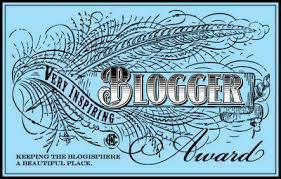 I want to thank Lauri Fortino, children’s book author and library assistant, who writes a blog called Frog On A Blog for nominating Frogs Are Green for the Very Inspiring Blogger Award! Starting 2015 off right! Her book, The Peddler’s Bed is coming in the Fall!
I want to thank Lauri Fortino, children’s book author and library assistant, who writes a blog called Frog On A Blog for nominating Frogs Are Green for the Very Inspiring Blogger Award! Starting 2015 off right! Her book, The Peddler’s Bed is coming in the Fall!
The award rules:
- Display the award on your blog
- Link back to the person who nominated you
- State 7 things about yourself
- Nominate 15 bloggers, link to them, and notify them about their nominations
Seven facts you didn’t know about me:
- In high school, I was torn between music and art and finally decided my path would be art (I sing, but only around here).
- I’m allergic to chocolate. (Sad, I know!)
- I wish I could have more animals… dogs, fish, birds. (Maybe I should move to the country?)
- I read almost every night, clears the mind of other thoughts.
- I truly love helping people and so glad that I get to everyday.
- Movies are my favorite pastime, old or new, just tell me a great story.
- I collect children’s picture books and yes, FROG things!
My sixteen nominations for the Very Inspiring Green Blogger Award (check them out!)
Blogger awards are a great way to spread the word about blogs that you enjoy. We can all use a bit of help getting the word out. If I’ve nominated you and you’d rather not participate, that’s fine, but do consider giving a shout-out for some of the blogs you follow. Those bloggers will appreciate your support.
By: frogs are green,
on 12/31/2014
Blog:
Frogs Are Green
(
Login to Add to MyJacketFlap)
JacketFlap tags:
Photographing Frogs and Toads,
A-Z Frogs,
frog eggs,
frogs in Australia,
Limnodynastes dumerilii,
Pobblebonk frogs,
Frogs,
Learn about Frogs,
Frog Conservation,
Frog People,
Teaching Kids about Frogs,
Amphibian research,
Add a tag
Rosemary Horton from Australia likes to keep Frogs Are Green readers up to date with her efforts to save frogs.
The photos below were taken with an ordinary digital camera through the lens of a school microscope, and shows the eggs and development of Pobblebonk Frogs (Limnodynastes dumerilii) to where she is ready to return them to suitable unpolluted areas.
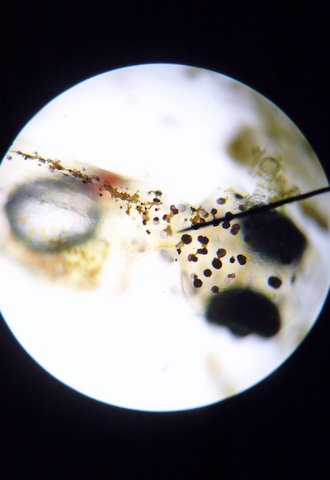
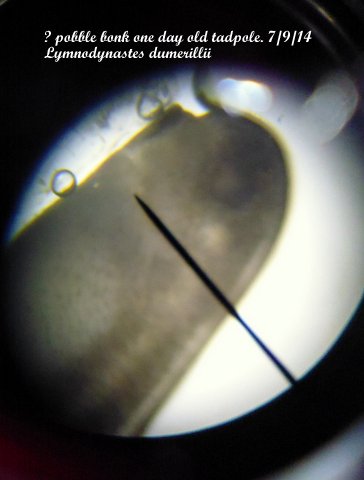
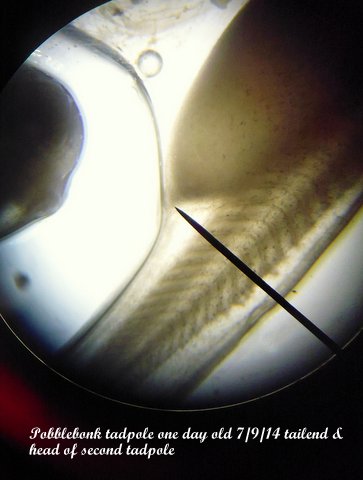
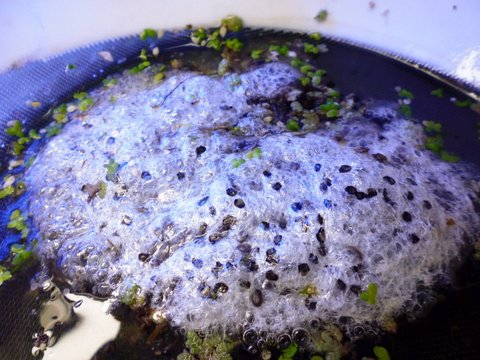
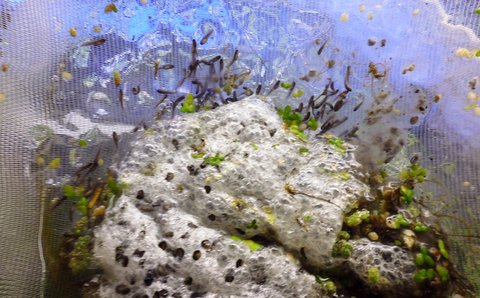
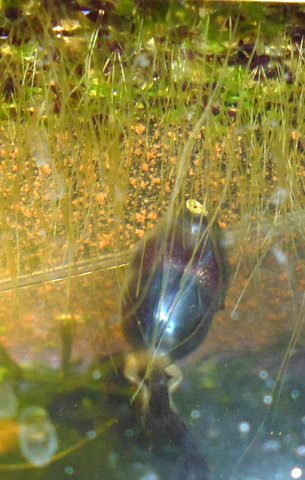
About Pobblebonk Frogs from Wikipedia.org:
Limnodynastes dumerilii is a frog species from the family Myobatrachidae. The informal names for this species, and its subspecies, include Eastern or Southern Banjo Frog, and Bull frog. The frog is also called the pobblebonk after its distinctive “bonk” call, which is likened to a banjo string being plucked. It is native to eastern Australia and has been introduced to New Zealand. There are five subspecies of L. dumerilii, each with different skin coloration.
By: frogs are green,
on 12/28/2014
Blog:
Frogs Are Green
(
Login to Add to MyJacketFlap)
JacketFlap tags:
Add a tag
The 14 judges are currently reviewing the entries submitted for the 2014 contests. There are so many incredible entries from across Jersey City, New Jersey, the United States and 32 countries around the world. The winners will be announced in January, 2015.
Here is the collected data for the 2014 Frogs Are Green Kids Art Contest: 973 Entries
32 Countries entered the 2014 Frogs Are Green Kids Art Contest
Australia, Bahrain, Bangladesh, Bulgaria, Canada, China, Croatia, England, Greece, Hungary, India, Indonesia, Iran, Ireland, Japan, Latvia, Malaysia, Morocco, Philippines, Romania, Russian Federation, Slovakia, Slovenia, South Africa, South Korea, Sri Lanka, Taiwan, Thailand, Turkey, Ukraine, United Arab Emirate, and USA.
17 States from across the USA entered the 2014 Frogs Are Green Kids Art Contest
Arizona, California, Florida, Georgia, Hawaii, Maryland, Michigan, New Jersey, New Mexico, New York, North Carolina, Ohio, Pennsylvania, South Carolina, Tennessee, Texas, and Wisconsin.
5 Cities in New Jersey entered the 2014 Frogs Are Green Kids Art Contest
Hoboken, Jersey City, Montclair, Piscataway, and South Brunswick.
16 Schools in Jersey City and Hoboken entered the 2014 Frogs Are Green Kids Art Contest
McNair Academic High School, PS #5, PS #23, MS #4, PS #3, PS #33, PS #28, MS #38, Golden Door Charter School, PS #25, PS #21, MS #7, Liberty High School, PS #31, Hoboken Catholic Academy, and the Hoboken Charter School.
Here is the collected data for the 2014 Frogs Are Green Photography Contests:
16 Countries entered the two 2014 Photography contests “Backyard Frogs” (34 entries) and “Frogs in the Wild” (56 entries)
Australia (NSW), Belize, Brazil, Costa Rica, Croatia, Denmark, England, Germany, India, Indonesia, Jamaica, New Zealand, Poland, Romania, Sri Lanka, and USA.
9 States in the USA entered the 2014 Frogs Are Green photography contests: “Backyard Frogs” and “Frogs in the Wild”
Arizona, Florida, Massachusetts, Minnesota, Nebraska, New Jersey, New York, North Carolina and Pennsylvania.
Below are the links to the 3 Flickr galleries, if you would like to see the imagery.
2014 Frogs Are Green Kids Art Contest
2014 Backyard Frogs Photo Contest
2014 Frogs in the Wild Contest
Thank you so much for your participation and good luck to all who entered! We would love to hear from the teachers and students! Tell us what you learned about frogs and amphibians! Tell us about the art mediums and techniques you used. If you’d like to post a video to the Frogs Are Green Facebook wall, we’d love to hear from you!
- Susan Newman, founder, Frogs Are Green, Inc. – A New Jersey nonprofit organization
By: frogs are green,
on 12/21/2014
Blog:
Frogs Are Green
(
Login to Add to MyJacketFlap)
JacketFlap tags:
Learn about Frogs,
frogs and pesticides,
Environmental Health,
Chemicals in the Environment,
Frog People,
atrazine,
Dr. Tyrone Hayes,
Syngenta,
frogs as bioindicators,
herbicides and frogs,
Amphibian research,
Frogs and Medicine,
A-Z Frogs,
Eco Interviews,
Amphibian Education Programs,
California Scientist,
Add a tag
This video is so important, we needed to share it on our site too. We have collaborated in the past with Save the Frogs on their campaign to Ban Atrazine.

Original broadcast:
http://www.democracynow.org – We speak with a University of California scientist Tyrone Hayes, who discovered a widely used herbicide may have harmful effects on the endocrine system. But when he tried to publish the results, the chemical’s manufacturer launched a campaign to discredit his work. Hayes was first hired in 1997 by a company, which later became agribusiness giant Syngenta, to study their product, Atrazine, a pesticide that is applied to more than half the corn crops in the United States, and widely used on golf courses and Christmas tree farms. When Hayes found results Syngenta did not expect — that Atrazine causes sexual abnormalities in frogs, and could cause the same problems for humans — it refused to allow him to publish his findings. A new article in The New Yorker magazine uses court documents from a class-action lawsuit against Syngenta to show how it sought to smear Hayes’ reputation and prevent the U.S. Environmental Protection Agency from banning the profitable chemical, which is already banned by the European Union.
Democracy Now!, is an independent global news hour that airs weekdays on 1,200+ TV and radio stations Monday through Friday. Watch our livestream 8-9am ET at http://www.democracynow.org.
By: frogs are green,
on 12/4/2014
Blog:
Frogs Are Green
(
Login to Add to MyJacketFlap)
JacketFlap tags:
amphibian curriculum,
building reach with seo,
frog art contest,
global reach,
learning about environment,
Learning Community Charter School,
Liberty State Park,
local reach,
nature in urban areas,
urban environments,
urban gardens,
Contests,
biodiversity,
Learn about Frogs,
Meet the Frogs,
How You Can Help,
Children and Nature,
Frog Conservation,
Frogs Are Green contests,
People Helping Frogs and Toads,
Frog People,
Frog fun,
frog photo contest,
Kids Art Contest,
Teaching Kids about Frogs,
Frogs Are Green kids' art contest,
Frogs in the Classroom,
A-Z Frogs,
wildlife conservation,
NJ Frogs Toads Amphibians,
Frogs and Artists,
Amphibian Education Programs,
Add a tag
We know that if we build a web presence with the right SEO (search engine optimization) over time we will reach those who are searching for what we are offering.
But what if your target audience isn’t looking for what you’re doing? How can we reach them?
This is the 5th year of the Frogs Are Green Kids Art Contest, so naturally those who have entered in the past are aware and may enter again. In addition, some parents and kids in countries around the world may be watching what other countries are doing and then get into the action as well. In the past 5 years we have received thousands of entries from more than 27 countries! When people are looking for something specific on the web and the right SEO is in place, those pages are found.
For example, Hong Kong has entered many beautiful artworks over the past few years, but this year in addition to the entries from China, we received entries from Japan, Malaysia and Indonesia. Last year we received some amazing art from Estonia, and this year from England, Ireland, Denmark, and Romania. Information can spread to new areas when we consistently push it out there and when the public is actively looking for it and then shares it, pushing it even further.
But the question today is how do we reach the ones nearby?
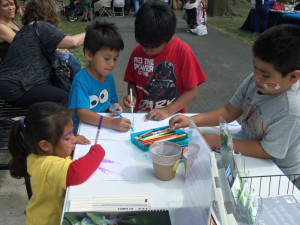
The answer is by introducing people to real-time situations where they are learning new things. If we want children who live in urban areas to understand nature and why saving frogs is important, we need to bring them to the source, yes bring them to nature. How can we expect children who live in urban environments to care about wildlife when it is somewhat foreign to them? This is why many classrooms today have class pets. So children can be directly involved in the health and well-being of those animals. But there is nothing better than showing them the animals’ true habitat.
Last Spring, Frogs Are Green made a presentation to 60 first-graders at the Learning Community Charter School in Jersey City, showing them both frog art from around the world and a slideshow of some of the most unusual frogs. They learn about frogs and amphibians as part of their school curriculum and they already knew quite a bit and were very enthusiastic about the topic.
During 2014 we developed a new six-week curriculum, “Frogs, Amphibians and their Threatened Environment – Discovery and Expression through Art” which is available for download, under the education tab on our website.
During the summer and early fall, we had set up tables at quite a few community fairs and events so children could stop by, sit down and draw frogs with the art supplies we laid out. Children love to create and don’t need that much encouragement once engaged. They just need the right guidance from teachers and parents. We also know that children love animals. Many have pets at home, but it’s not the same as seeing those animals in nature.
If we want children to care about nature, we must show it to them, through field trips and when they see the real thing it will lead them to care what happens in the future.
What’s cool is that even in urban areas there are parks, such as our own Liberty State Park. Imagine the fantastic discovery students might have by seeing everything from frogs to birds, and more if they just went there with an educator.
We see a sharing cycle of teachers educating children, who bring that information home and tell their parents, who then share that with other parents, who share it with their kids and on to community leaders.
The key is getting those sparks of information and creativity started in the right places and making sure the people you want to reach are receiving it.
by Susan Newman, founder
By: frogs are green,
on 12/4/2014
Blog:
Frogs Are Green
(
Login to Add to MyJacketFlap)
JacketFlap tags:
frogs in your garden,
garden insects,
healthy eco-systems,
Insects,
Learn about Frogs,
How You Can Help,
Environmental Health,
People Helping Frogs and Toads,
Frog People,
making a toad abode,
Amphibian habitat loss,
Deforestation and amphibians,
toad abode,
Creating a Wildlife Friendly Backyard,
Teaching Kids about Frogs,
frogs and toads,
A-Z Frogs,
Frogs and Insects,
Add a tag
Frogs and toads are some of nicest critters you can attract in your garden as they can improve it great deal. They have true and undeniable value but are threatened by the constant increase of urbanization. Their habitats are shrinking at an alarming rate and thus reducing their chance of survival.
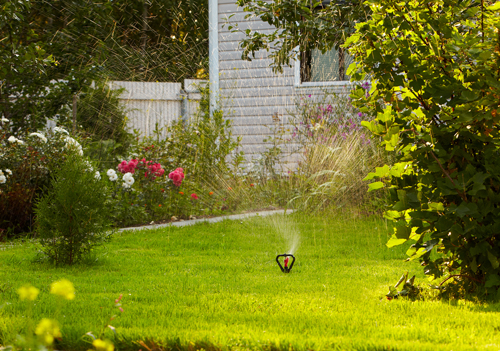
So why not take steps in inviting them in your garden today? For one thing, they are amazing pest control predators. They feed on insects, such as cutworms, caterpillars, sow bugs and many more that can do harm to your garden. There have been reports of entire gardens destroyed by these bugs for a single night, and anything that can help prevent that from happening is to be loved and preferred over other animals. A single frog can eat over a hundred harmful insects a day, which is really a lot and enough in most cases to help you control this threat.
In order to ensure that frogs can perform their duty, you will need to create a suitable habitat for them. During the day, they like to sit under shady and cool areas, such as under trees and other high plants. There are many solutions that can be implemented in your garden which will offer not only proper shelter for frogs, but will also give your garden an innovative look. These animals also require water, so a pond of some sort is needed. Many professional and reliable gardeners share the opinion that there is nothing quite like having a garden pond in your backyard. It needs to have shallow edges to allow the amphibians to enter and leave as they please.
Toads and frogs can be a garden’s best friend and save you the need to spray with pesticides and other chemicals to protect from insects. If you like the calming and sometimes gentle sound of frogs, then smile the next time you see one in your garden.
Guest blog by Ella Andrews
By: frogs are green,
on 11/30/2014
Blog:
Frogs Are Green
(
Login to Add to MyJacketFlap)
JacketFlap tags:
amphibian art curriculum,
backyard frogs photo contest,
conservation wildlife calendars,
frog conservation posters,
frog photo contest 2014,
Frogs and Dragonflies 2015 calendar,
frogs are green founder,
frogs are green tee shirts,
kids art contest 2014,
north carolina wildlife photographer,
Sustainable Jersey,
The Cloud Institute,
wildlife 2015 calendar,
Learn about Frogs,
How You Can Help,
Children and Nature,
Frog Conservation,
Frogs Are Green contests,
Frog People,
Climate change and frogs,
frog gifts,
Frog posters,
Frog fun,
Kids Art Contest,
Teaching Kids about Frogs,
Frogs Are Green kids' art contest,
Frogs Are Green posters,
Frogs Are Green Photo Contests,
Climate change and the Environment,
Photographing Frogs and Toads,
frogs in the wild photography contest,
A-Z Frogs,
Wes Deyton,
Sustainable JC,
Frogs and Artists,
Amphibian Education Programs,
Add a tag
This time of year most are busy running around collecting this and that for their loved ones. I want to take this opportunity to express my thanks for all the frog loving fans who have read, shared and posted photos, artworks and interesting news items.
The contest entries are flying in from all over the globe. Artworks have come in from: South Korea, Bahrain, Slovakia, Germany, India, Indonesia, Bangladesh, Japan, Russian Federation, Morocco, England, Ireland, Australia, Denmark, Romania, Sri Lanka, Costa Rica and USA. There are just two weeks left to submit yours! The deadline is Dec. 15, 2014.
2014 Kids Art Contest hosted by Frogs Are Green
2014 Photo Contest hosted by Frogs Are Green
Frogs Are Green is a New Jersey nonprofit organization and we depend on the modest donations and sales from tee shirts, posters and calendars. Please purchase our NEW 2015 Frogs and Dragonflies calendar with exceptional photography by Wes Deyton, wildlife photographer in North Carolina, or one of our magnificent conservation posters showcasing collaborations from some of the most well known artists and photographers!
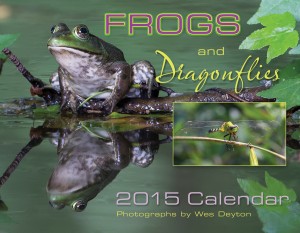
If you are looking for a winter project to do with your children, download the FREE “Frogs, Amphibians and their Threatened Environment – Discovery and Expression Through Art,” 6 week curriculum!
I also wish to mention that I am enrolled in NJ Learns (a partnership between The Cloud Institute and Sustainable Jersey, thanks to my advocate, Sustainable JC, and through this education on sustainability, I am seeing more clearly, new educational ways to reach children and the general public. Look for expanded offerings as we move into 2015!
Wishing you all a very happy holiday season!
- Susan Newman, founder, Frogs Are Green
By: frogs are green,
on 11/18/2014
Blog:
Frogs Are Green
(
Login to Add to MyJacketFlap)
JacketFlap tags:
wildlife conservation,
garden pond,
attracting Newts to pond,
ideal outdoor habitat,
Newts and salamanders,
biodiversity,
Salamanders,
How You Can Help,
frog pond,
Children and Nature,
Environmental Health,
People Helping Frogs and Toads,
Creating a Wildlife Friendly Backyard,
Teaching Kids about Frogs,
Add a tag
Encouraging newts to your garden pond will add life and color that can be seen for much of the year. You should never remove them from the wild but there are a few steps you can take to invite them to take up residence in your pond.
Newts not only add life to the pond, they also eat algae. So they provide a natural solution to a common problem. As they are most active during the warmer months of the year, when algae is rifer, they can be a real help. Of course other natural remedies such as Barley Straw will help too.
The best way to invite newts into your garden is to create the ideal habitat. A natural pond without fish is the best environment, as they will eat newt eggs and spawn.
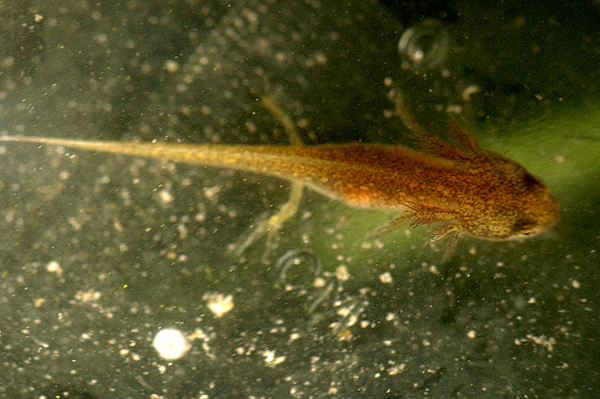
Build a loose rockery around or near the pond. This will provide them with shelter to live and breed. The cool, damp, atmosphere is ideal for newts, and will encourage slugs and insects, a good food source. If you want to feed the newts, then you can add bloodworm, daphnia or brine shrimp to the water, a good retailer will have a wide range of pond foods.
Adding plants such as water mint or water forget-me-nots are small but have wide leaves which are perfect for newts to lay and hide their eggs in. Reed plants are also great to promote natural behaviors. The eggs have a jelly like texture, which newts wrap up in leaves to protect them.
Newts are most active from March/April, and you should see babies appear from June to August. From then on, you will notice that they start to disappear, as they mostly hibernate throughout the winter, until around February. During this time, try not to rearrange the rockery or do too much work around the area, as this will disturb the newts.
Children will no doubt be very interested in the new addition to your pond, and it’s a great way to promote a love of nature. However always supervise your children around these slippery creatures, and ensure that if they do pick a newt up, that they do so very gently and with wet hands. Don’t allow the newts to be taken away from the area, or held for more than a few minutes.
You may find that not only newts arrive, but that frogs and toads appear too. As they thrive in similar environments. They can live well together and create a beautifully natural area of wildlife in your garden.
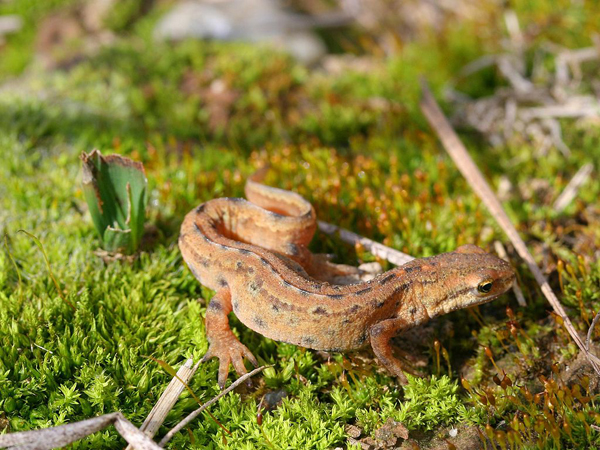
Don’t worry if newts don’t start to arrive, despite the lovely home you have created. It may take time for them to appear and breed. If your local environment has changed, such as new roads, building sites etc., this may affect the migration of newts too. Leaving the pond and its inhabitants to its own devices will encourage the most natural behaviors and results.
By: frogs are green,
on 10/9/2014
Blog:
Frogs Are Green
(
Login to Add to MyJacketFlap)
JacketFlap tags:
Teaching Kids about Frogs,
Amphibian research,
Climate change and the Environment,
Frogs in the Classroom,
Photographing Frogs and Toads,
A-Z Frogs,
wildlife conservation,
Sustainable Choices,
Off-site conservation programs,
Children's Books on Frogs,
Frogs and Artists,
Amphibian Education Programs,
Frame of Mind,
In Search of Lost Frogs,
International League of Conservation Photographers,
interview with Robin Moore,
National Geographic Creative,
Robin Moore,
Environmental Books,
biodiversity,
Meet the Frogs,
How You Can Help,
habitat loss,
Children and Nature,
frog exhibits,
Frog Conservation,
Frogs and the Rainforest,
People Helping Frogs and Toads,
Frog People,
Read about Frogs,
Amphibian habitat loss,
amphibian conservation,
Literary Amphibians,
Climate change and frogs,
Rainforest Frogs,
Amphibians in films,
Frogs in Film,
Deforestation and amphibians,
frogs as bioindicators,
Add a tag
Exclusive!
Tune in tomorrow, October 10, 2014 at 3pm EST and meet…
Robin Moore, conservationist, photographer and author of “In Search of Lost Frogs.”
The live podcast interview is here:
Webcast: Robin Moore interviewed by Susan Newman
Phone: 1-724-444-7444
126288#
1#
Follow the event on Facebook:
Robin Moore Interview on Facebook with Susan Newman (aka Suzy Brandtastic)
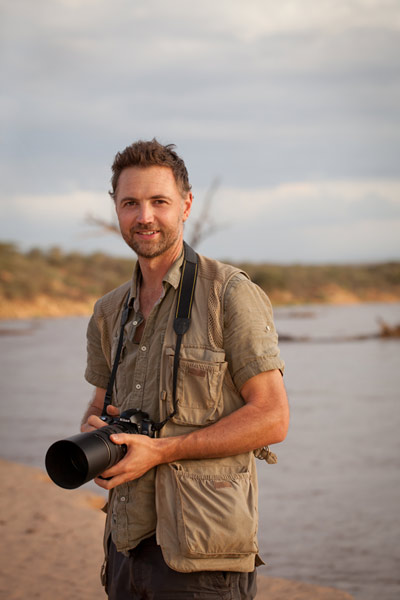
About Robin Moore:
Robin Moore is a conservationist, photographer and the author of In Search of Lost Frogs (In Search of Lost Frogs).
Since gaining a PhD in biodiversity conservation, Robin has been a powerful voice for amphibian conservation.
He is a Conservation Officer with Rainforest Trust, Global Wildlife Conservation and the Amphibian Survival Alliance, the largest global partnership for amphibian conservation.
He is a proud Senior Fellow of the International League of Conservation Photographers (www.ilcp.com), represented by National Geographic Creative, and recently Co-Founded Frame of Mind (www.frameofmind.org), an initiative that empowers youth around the world to connect with their natural and cultural worlds through photography and visual.
_____________________________________
About Suzy Brandtastic interviews:
Susan Newman, an environmentalist and brand visibility designer knows how important it is to tell your “why.” Susan hosts a podcast series, live action video series and a written interview series, all featuring environmentalists, innovators, creatives and small business owners.
View Next 25 Posts




























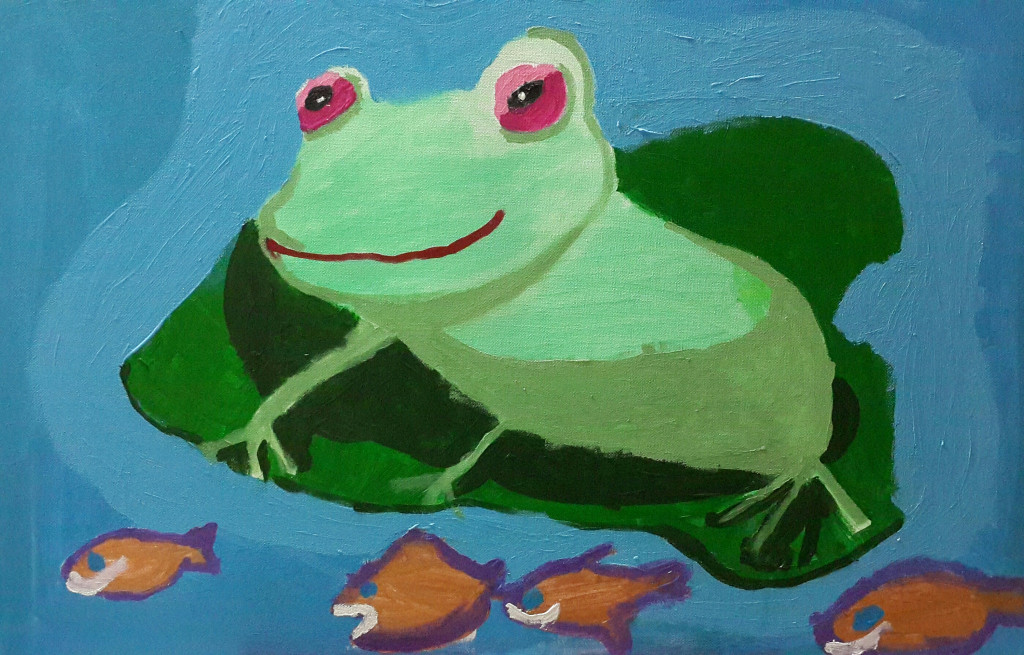































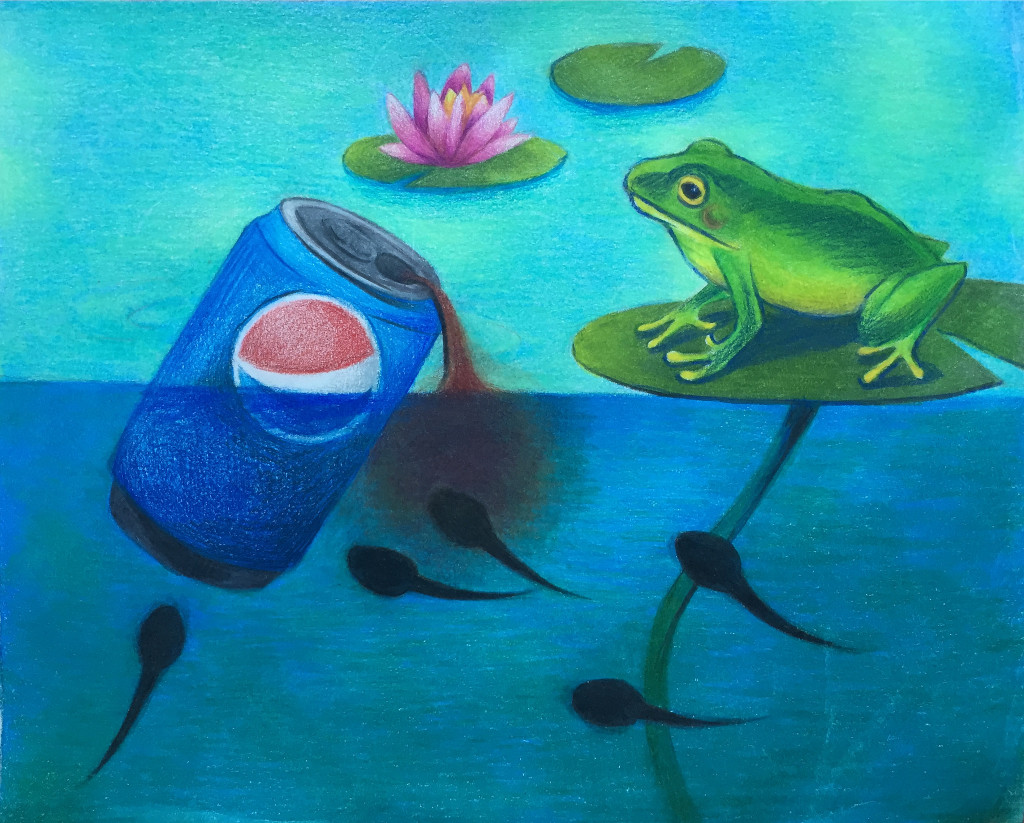

































 I want to thank Lauri Fortino, children’s book author and library assistant, who writes a blog called
I want to thank Lauri Fortino, children’s book author and library assistant, who writes a blog called 











